

San Pedro de Atacama Celestial Explorations
The complete solution to observe the atacama sky.
- Local-Weather2
- Local Weather
- Trip to Chile
- The astronomical Chile
- Frequently Asked Questions
- Telescope Rental
- Telescope Hosting
- Telescope Time Rental
- Getting there
- San Pedro de Atacama
- Sales conditions
- Image Gallery
- Pictures of Atacama Lodge
- How to polar align in the southern hemisphere
- How he believed he killed Pluto alone, and why it had it coming.
- Is wild capitalism the best humanity has to offer to the Solar System ? (updated May 30th 2020)
- NEA stats 2018
- De la catastérisation à la catastéroïdation...
- Starlink = Star kill ?
- La grande conjonction du 21 décembre 2020
- Pluto festival of disinformation
- Astrophotos
- Don't look up
- Photographie
- Images du ciel
- Instruments
Celestial discovery tours
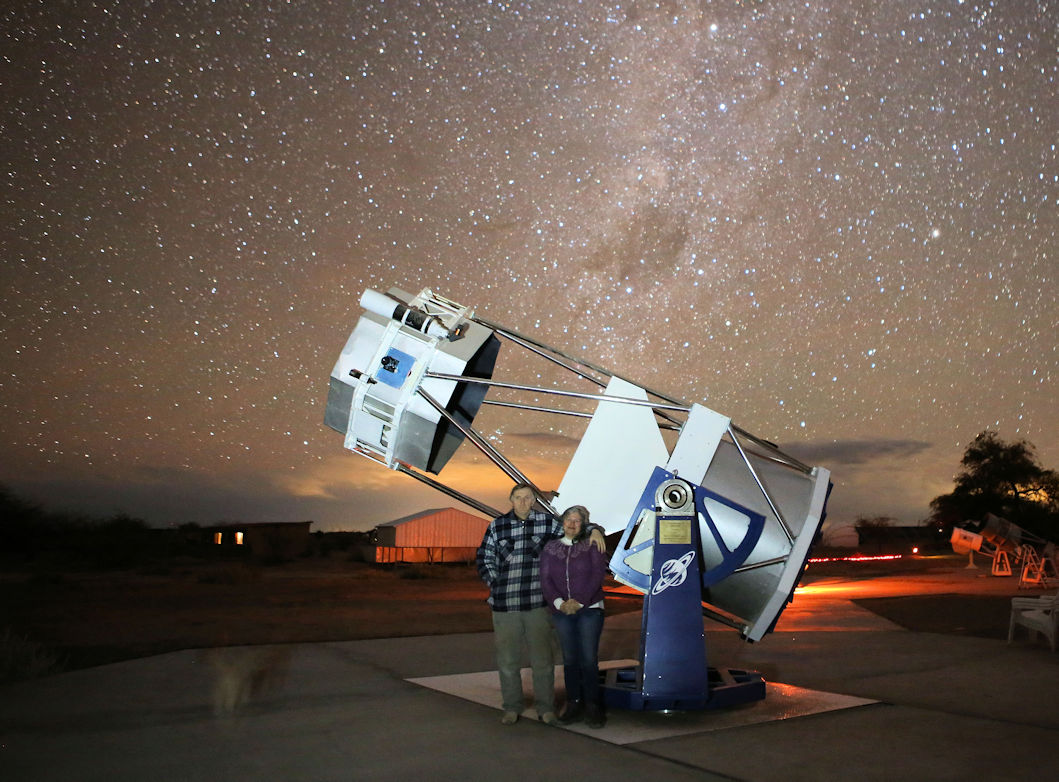
SPACE (San Pedro de Atacama Celestial Explorations) has been operating in San Pedro since 2003. It was only about ten years later that other agencies in San Pedro started astronomical tourism, which is our only activity.
Today there are more than fifty agencies in San Pedro that offer astronomical tours, with "variable" qualities.
We offer different services every night except the 7 nights around the full moon (the moon is too bright, you can see almost nothing in the telescopes, except bright objects such as the moon or planets).
- General astronomical tours, for a generally uninformed audience
- Private astronomical tours, for small groups (no one other than your group participates in the tour)
- Bucket list tour, for experienced amateur astronomers who want to discover the nebulae of the southern sky through a large diameter telescope.
- Accommodation in our lodges with or without observation equipment rental
Our tours can be in French, English, Spanish and more rarely Portuguese. It is impossible to translate the tour in real time (without disturbing other participants).
The start time varies depending on the season (first round at 7pm in winter, 9pm in summer). All of this is made clear when we confirm your turn.
Bookings can only be made via the internet , and it is common for the tours to be booked a few weeks in advance. Please do not book if you are not sure to come. We typically reject 10 to 20 persons per night, which could have taken your reservation.
The completion of the tour obviously depends on the weather conditions. In general, the weather in San Pedro is fine. Sometimes the sky is cloudy, and unfortunately there are evenings when it is very difficult to predict how the weather will evolve. Sometimes we cancel a tour and an hour later the sky is perfectly clear. Or the other way around, we make the decision to do the tour (half an hour before the start of the tour) and then once the tour starts the sky is overcast. Meteorology is not an exact science.
The temperature at night is usually colder than during the day, so it's essential to dress warmly.
Some people tend to confuse holidays with commando training. It's a good idea to take time and not overload your schedule. You are on vacation. For example, do not visit the Tatio geysers (get up at 4 a.m.), then end the day with the astronomical tour (which can end at one o'clock in the morning the next day). In the same way, don't do the astronomical tour the night before your visit to the geysers a few hours later.
Children are accepted, as long as they do not disturb the participants of the tour (i.e. no screaming, crying, children running around the telescopes, or climbing on them). In all cases, parents are responsible for their children during the tour.
Astronomical Tours:
They are limited to a maximum of 16 people, often less.
The starting point is in front of the E26 school in San Pedro, Calle Ignacio Carrera Pinto (we will send you a map when you make your reservation). Our bus has a clear "SPACE" sign in the front.
At the end of the tour, our bus will take you back to your hotel or near your hotel.
The tour lasts from two to three hours. It includes a general introduction to the sky, and its observation with the naked eye, followed by an observation using large diameter telescopes giving an exceptional view of celestial objects. At the end of the tour, we return to the warmth, finish the tour by offering you a hot drink. We also take a souvenir photograph in front of the telescope and the starry sky.
The current price is 40000 pesos. It can be paid in credit card, pesos, US dollars or even euros.
We do not work with any other agencies in San Pedro. In other words, there have been agencies that claim to work with us and then send you to another observatory with smaller telescopes, and less competent guides. In the same way, there are agencies that use photographs of our telescopes on their web pages. San Pedro = Touristic Wild West
Private Tours:
In this tour, only people from your group are admitted. If the number is limited, we only use the largest telescope.
The bus picks you up from your hotel and takes you back there at the end of the tour.
Contact us for the rate which depends on the number of people.
Bucket list tour.
The "bucket list" is the list of things you would like to do before you die (kick the bucket in American). The name comes from the fact that two of the first participants told us that observing objects in the southern sky once in a large telescope was on their bucket list. The number of people is very limited for the simple reason that when the group exceeds 4 people, it takes a long time to move from one object to another. This tour is intended for experienced amateur astronomers who don't need explanations about the sky with the naked eye, constellations, etc.
This tour includes an overnight stay in one of our lodges and takes place as follows. You arrive in the afternoon or late afternoon. At the beginning of the night, while the first regular tour observes the sky with the naked eye, we have a first session to observe the celestial objects in the western sky. At the end of our regular tours (midnight or one o'clock in the morning depending on the season), we have a second, longer session to observe what is visible at that time. At the end of the night, we can possibly do a last session to observe the objects in the eastern sky. You end the night sleeping in the lodge, which allows for a more restful sleep than in hotels in the city where "normal" guests get up at seven in the morning without much respect for people who want to sleep longer.
This tour allows you to observe dozens of objects in the sky, those that are our favorites but also yours if they are different. We don't limit ourselves only to objects in the southern sky of course (the Veil nebula in Cygnus is fantastic in the 1m15 telescope).
Telescopes:
One of the reasons for participating in our tours is the fact that we have large telescopes, which, not surprisingly, give much better images than in the much smaller telescopes used in the other astronomical towers in San Pedro and elsewhere in Chile. In the best case scenario, on San Pedro you will be able to observe through a telescope of 30 or 40cm in diameter. This gives good images of bright objects (moon and planets) and are difficult to show nebulae and other galaxies.
Varying according to the size of the group (sometimes we receive groups exceeding 50 people in which case we use more telescopes), for "normal" groups of 14 to 16 people, we use 60cm telescopes, a 72cm telescope, and a 1m15 diameter telescope which is the largest telescope accessible to the public in the southern hemisphere.
These telescopes are well maintained with good optical collimation (i.e. not like in some tours where the so-called guides have no idea how to adjust their telescope)
The other point is obviously the eyepieces. The "magnifying glass" through which the eye observes. There is a whole range of eyepieces, with very different apparent fields of view and prices. Oddly enough, you can see much better in a $500 to $1,000 eyepiece like the ones we have than in the $50 eyepieces sold with commercial telescopes.
There are obviously much larger telescopes in Chile, especially those of the European Southern Observatory, but on the one hand they are booked in advance by groups of professional astronomers on research programs and on the other hand, equipped with electronic cameras and other spectrographs, they are not suitable for visual observation, there are no eyepieces available. These observatories are only open to the public during the day, on Saturdays. No visual observation is possible using these telescopes.
Share this page
- Address: Réservations par internet seulement
- Email: info SPAMFILTER @spaceobs.com
- Phone: No telephone
- Cellphone: No telephone
- Website: www.spaceobs.com
- Atacama Lodge

Smithsonian Journeys Travel Quarterly: Inca Road
A Smithsonian magazine special report
An Astronomer’s Paradise, Chile May Be the Best Place on Earth to Enjoy a Starry Sky
Chile’s northern coast offers an ideal star-gazing environment with its lack of precipitation, clear skies and low-to-zero light pollution
Govert Schilling
/https://tf-cmsv2-smithsonianmag-media.s3.amazonaws.com/filer/58/a1/58a13a6e-8f56-4feb-a7fb-38c2e83cc150/42-57433134.jpg)
The view through the eyepiece of the telescope is breathtaking. Like tiny diamonds on black velvet, countless sparkling stars float against a fathomless backdrop of empty space. “This is Omega Centauri,” says astronomer Alain Maury, who runs a popular tourist observatory just south of San Pedro de Atacama in northern Chile. “To the naked eye, it looks like a fuzzy star, but the telescope reveals its true nature: a huge, globular cluster of hundreds of thousands of stars, almost 16,000 light-years away.” I could take in this mesmerizing view for hours, but Maury’s other telescopes are trained at yet more cosmic wonders. There’s just too much to see.
Chile is an astronomer’s paradise. The country is justly famous for its lush valleys and snowcapped volcanoes, but its most striking scenery may be overhead. It is home to some of the finest places on Earth to enjoy the beauty of the starry sky. If there’s one country in the world that really deserves stellar status, it’s Chile.
If you live in a city, as I do, you probably don’t notice the night sky at all. Yes, the moon is visible at times, and maybe you can see a bright planet like Venus every now and then, but that’s about it. Most people are hard-pressed to recognize even the most familiar constellations, and they’ve never seen the Milky Way.
Not so in Chile. A narrow strip of land, 2,700 miles long and 217 miles at its widest point, Chile is tucked between the Andes Mountains to the east and the Pacific to the west. It stretches from the arid Atacama Desert in the north to the stark granite formations of the Torres del Paine National Park in the south. Large parts of Chile are sparsely populated, and light pollution from cities is hardly a problem. Moreover, the northern part of the country, because of its dry desert atmosphere, experiences more than 200 cloudless nights each year. Even more important to stargazers, Chile provides a clear view of the spectacular southern sky, which is largely invisible from countries north of the Equator.
Long before European astronomers first charted the unknown constellations below the Equator, just over 400 years ago, the indigenous people of Latin America knew the southern sky by heart. Sometimes their buildings and villages were aligned with the heavens, and they used the motions of the sun, the moon and the stars to keep track of time. Their night sky was so brilliant that they even could recognize “dark constellations”— pitch-black, sinuous dust clouds silhouetted against the silvery glow of the Milky Way. The Inca dark constellation of the llama is particularly conspicuous, as I noticed during my visit to Maury’s observatory.
It wasn’t until the mid-20th century that Western astronomers were drawn to Chile, in a quest for the best possible sites to build Southern Hemisphere observatories. Americans and Europeans alike explored the mountainous regions east of the port of La Serena, a few hundred miles north of the country’s capital, Santiago. Horseback expeditions lasting for many days—back then, there were no roads in this remote part of the world—took them to the summits of mountains like Cerro Tololo, Cerro La Silla and Cerro Las Campanas, where they set up their equipment to monitor humidity (or lack thereof), sky brightness and atmospheric transparency.
Before long, astronomers from American institutions and from the European Southern Observatory (ESO) erected observatories in the middle of nowhere. These outposts experienced their heyday in the 1970s and 1980s, but many of the telescopes are still up and running. European astronomers use the 3.6-meter (142 inches) telescope at the ESO’s La Silla Observatory to search for planets orbiting stars other than the sun. A dedicated 570-megapixel camera attached to the four-meter (157 inches) Blanco Telescope at Cerro Tololo Inter-American Observatory is charting dark matter and dark energy—two mysterious components of the universe that no one really understands.
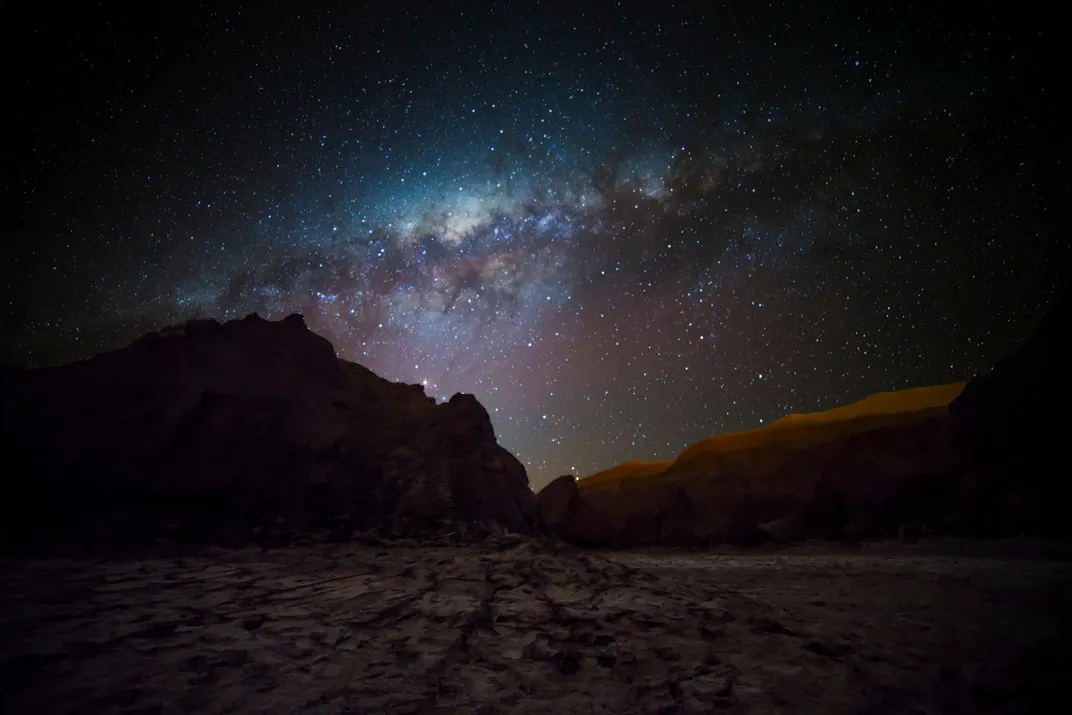
If you’re star trekking in Chile, it’s good to know that most professional observatories are open for tourists one day each week, usually on Saturdays. Check out their schedules in advance to prevent disappointment—the drive from La Serena to La Silla may take almost two hours, and the curvy mountain roads can be treacherous. I once got my four-wheel-drive pickup truck in a spin while descending the gravel road from Las Campanas Observatory, a scary ride I hope never to repeat. Also, dress warm (it can be extremely windy on the summits), wear sunglasses and apply loads of sunblock.
Most professional observatories are open to visitors only during daytime hours. If you’re after a nighttime experience, the region east of La Serena—especially Valle de Elqui—is also home to a growing number of tourist observatories. The oldest is Mamalluca Observatory, some six miles northwest of the town of Vicuña, which opened in 1998. Here amateur astronomers give tours and introductory lectures, and guides point out the constellations and let visitors gaze at stars and planets through a number of small telescopes. Everyone can marvel at the view of star clusters and nebulae through the observatory’s 30-centimeter (12 inches) telescope.
You can look through a 63-centimeter (25 inches) telescope at Pangue Observatory, located ten miles south of Vicuña. At Pangue, astronomy aficionados and astrophotographers can set up their own equipment or lease the observatory’s instruments. Farther south, near the town of Andacollo, is Collowara Observatory, one of the newest tourist facilities in the region. And south of La Serena, on the Combarbalá plain, is Cruz del Sur Observatory, equipped with a number of powerful modern telescopes. Most observatories offer return trips to hotels in Pisco Elqui, Vicuña or Ovalle. Tours can be booked online or through travel agents in town.
I will never forget my first look at the Chilean night sky in May 1987. I was awed by the glorious constellations of Scorpio and the Southern Cross, the star-studded Milky Way with its many star clusters and nebulae, and of course the Large and Small Magellanic Clouds (two companion galaxies to our own Milky Way). Using today’s digital equipment, all of this can be captured on camera. Little wonder that professional astrophotographers have fallen in love with Chile. Some of them have the privilege of being designated photo ambassadors by ESO: They get nighttime access to observatories, and their work is promoted on the ESO website.
Every traveler to Chile interested in what’s beyond our home planet should visit—and photograph—the country’s Norte Grande region. It’s a surrealistic world of arid deserts, endless salt flats, colorful lagoons, geothermal activity and imposing volcanoes. East of the harbor town of Antofagasta, the Atacama Desert looks like a Martian landscape. In fact, this is where planetary scientists tested the early prototypes of their Mars rovers. The alien quality of the terrain makes you feel as if you’re hiking on a forbidding yet magnificent planet orbiting a distant star.
The 45-mile gravel road that took me through the rock-strewn Atacama from Ruta 5 (Chile’s main highway) to Cerro Paranal during my first visit there in 1998 has since been paved, providing much easier access to the ESO’s Very Large Telescope (VLT)—one of the foremost professional astronomical observatories in the world. Here, 8,645 feet above sea level, astronomers enjoy the serene spectacle of sunset above the Pacific Ocean before they switch on the four huge 8.2-meter (323 inches) Unit Telescopes, which are equipped with high-tech cameras and spectrographs that help them unravel the mysteries of the universe. And yes, even this temple of ground-based astronomy is open to visitors only on Saturdays.
A couple hundred miles to the northeast, tucked away between the Cordillera de la Sal mountain range and the Altiplano on the border with Argentina, is the oasis of San Pedro de Atacama. The region was inhabited thousands of years before the Spanish conquistadors built the first adobe houses and a Roman Catholic church in the 17th century—one of the oldest churches in Chile. Today San Pedro is a laid-back village, populated by backpackers and lazy dogs. It serves as the hub for exploratory trips to the surrounding natural wonders, from the nearby Valle de la Luna to the remote El Tatio geyser field.
Even though electric street lighting was introduced in San Pedro some ten years ago, it’s hard to miss the stars at night. A few steps into a dark side road will give you an unobstructed view of the heavens. Don’t be surprised, while you’re sipping a pisco sour in one of the many restaurants in town, to hear American, European or Japanese visitors talk about the big bang, the evolution of galaxies, or the formation of stars and planets. Over the last couple of years, San Pedro has become a second home for the astronomers of the international ALMA observatory.
ALMA (Atacama Large Millimeter/submillimeter Array) is the latest addition to Chile’s professional astronomical facilities. It’s one of the highest (altitude: 16,40 feet) and largest ground-based observatories in the world, with 66 antennas, most of them 12 meters (40 feet) across. The actual observatory, at the Llano de Chajnantor, some 30 miles southeast of San Pedro, is not open to tourists, but on weekends, trips are organized to ALMA’s Operations Support Facility (OSF), where you can visit the control room and take a look at antennas that have been brought down for maintenance. On clear days the OSF offers stunning views of nearby volcanoes and over the Salar de Atacama salt flat. While ALMA studies invisible radiation from distant stars and galaxies, San Pedro also affords many opportunities for old-fashioned stargazing. Some fancy resorts, like Alto Atacama and Explora, have their own private observatories where local guides take you on a tour of the heavens.
But if you really want to immerse yourself in the Chilean night sky, I strongly recommend a visit to SPACE, which stands for San Pedro de Atacama Celestial Explorations. Here, French astronomer and popularizer Maury and his Chilean wife, Alejandra, welcome you with hot chocolate, warm blankets and entertaining stories about the history of astronomy before they take you to their impressive telescope park.
It was here that I got my first look at the globular cluster Omega Centauri. I marveled at the clouds of Jupiter, the rings of Saturn, binary stars, softly glowing nebulae, glittering groups of newborn stars and distant galaxies. Suddenly the world beneath my feet turned into an inconspicuous speck of dust in a vast, incredibly beautiful universe. As the famous American astronomer Carl Sagan once said: “Astronomy is a humbling and character-building experience.” The Chilean night sky touches your deepest self.
For professional astronomers, Chile will remain the window to the universe for many years to come. On Cerro Las Campanas, plans are in place to build the Giant Magellan Telescope, featuring six 8.4-meter (330 inches) mirrors on a single mount. Meanwhile, the European Southern Observatory has chosen Cerro Armazonas, close to Paranal, as the site for the future European Extremely Large Telescope (E-ELT). This monster instrument—which would be the largest optical/near-infrared telescope ever built—will have a 39-meter (128 feet) mirror consisting of hundreds of individual hexagonal segments. It is expected to revolutionize astronomy, and it may be able to detect oxygen and methane—signs of potential life—in the atmospheres of Earthlike planets orbiting nearby stars.
In 2012 I drove the bumpy trail to the summit of Armazonas, and took a small stone for a souvenir. Two years later the mountaintop was flattened by dynamite to create a platform for the E-ELT. One day I hope to return, to see the giant European eye on the sky in its full glory. But well before the telescope’s “first light,” Chile will beckon me again, to witness the wonder of a total solar eclipse, both in July 2019 and in December 2020.
I have to admit I’m hooked. Hooked by the cosmos, as seen and experienced from the astronomical paradise of Chile. You’ll understand when you go there and see for yourself. Who knows, one day we may run into each other and enjoy the view together.
Get the latest Travel & Culture stories in your inbox.
Govert Schilling | READ MORE
Govert Schilling is the prize-winning author of dozens of popular astronomy books. He writes about astronomy and space science for newspapers and magazines from his hometown of Amersfoort, the Netherlands.
THE HIGHEST EXPERIENCE IN SOUTH AMERICA
The Sky Costanera Viewpoint is a unique space in Latin America, where you can enjoy the Andes Mountains and iconic places in Santiago de Chile from a completely new perspective.
Come, climb to the top with us! Sky Costanera is open 7 days a week, 365 days a year. With our elevators, in less than a minute you will be at the highest point in Latin America.
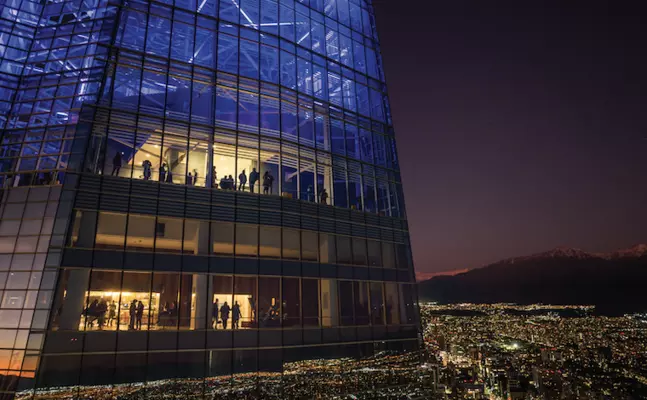
BE PART OF AN UNFORGETTABLE EXPERIENCE AT SKY 300 BAR & COFFEE
Sky 300 Bar & Coffee is a new experience in the most impressive viewpoint in South America. An ideal place to share with the whole family and friends, together with an exclusive menu of signature cocktails, first class gastronomy and a great atmosphere, we are waiting for you from 10:00 a.m. to 10:00 p.m. Get ready to enjoy with us at 300m high!
Sky Costanera
Open - Closes at 22:00 hrs.
* Last elevator up 21:00 hrs.
- Ticket office and entrance by level
- Ground floor of the center
- Commercial Costanera Center
SKY COASTAL ON TRIPADVISOR
Sky Costanera is the unmissable starting point to live and get to know Santiago. Experience in 360 degrees at 300 meters high in the highest viewpoint in Latin America! The place where you can observe the capital of our country in 360° and enjoy its landscape, see the valley where the city is located, its geography, enjoy the Andes mountain range and its majesty, and be surprised by the modern architecture of Santiago.
Wonderful, recommended
Everything is very organized, the elevator takes less than 1 minute to go up the 62 floors. The view of the city is wonderful, I recommend going around 8:00 p.m. to wait for the sunset and then see the city illuminated at night.

Mónica Otero
Sky waterfront...
You have to visit it without a doubt, the viewpoint is beautiful on the 62nd floor... excellent views of the city... there is a cafeteria to stay a while to contemplate them. The shopping is very good, complete even with the jumbo supermarket on the ground floor. Highly recommended!
Maite Jorquera
Very nice, going at night makes it a great experience
A very nice and pleasant place, it is a guided experience from the moment you get on the elevator, it is highly recommended to go during the week and at night, the prices are more accessible and we are empty, you can enjoy it more
Very nice walk!
The view is amazing. The comfortable and cute place. It is unmissable. My 8-year-old son was fascinated by looking through the binoculars, which are free.
Nani Candeias
Shocking View
It is a place that allows a wonderful view of Santiago, it is a unique and very entertaining experience.
360-degree views of all of Santiago, beautiful, 62 floors by elevator, upon arrival you find the city at your feet, and there is no photo or video that can show what the eyes can appreciate while there. If you like the best views you can't miss it.
Chile Astronomy Adventure
- Get inspired by the possibilities.
- Build your ideal trip.
- Watch the sunset from the giant sand dunes in the Valley of the Moon
- Explore the salt flats of Atacama Desert
- View the stars from some of the clearest skies on earth
- Tour some of the world's most technologically advanced space observatories
- Village Visits
- Archaeological Site Visits
- South America
- Andes Mountains
- Atacama Desert
- Pisco Elqui
- San Pedro de Atacama
- Valley of the Moon
Full Itinerary
Day 1: arrive la serena | city tour, day 2: gemini observatory | valle del elqui.
- 1 Breakfast, 1 Lunch
Day 3: La Silla Observatory
Day 4: fly to calama | san pedro de atacama.
- 1 Breakfast
Day 5: Moon Valley Tour
Day 6: el tatio geysers, day 7: alma observatory, day 8: fly santiago and home, accommodations, hotel casa don tomas, hotel costa real, elqui domos, dates & prices, my preferred start date.
Initial deposit is 20% ($400 minimum), and most travelers will call our office and pay the deposit with a credit card.
Final payment is due 70 days (10 weeks) prior to departure by bank transfer, check or credit card. All final payments by credit card may be subject to a surcharge and maximum of $20,000 charge
See our general terms and conditions:
- Adventure Life Terms & Conditions
We are an agent for one or more providers on this trip with specific cancellation policies and terms:
- Cascada Expediciones - Terms and Conditions - Cascada Expediciones
For full cancellation policy details, please contact us for a quote.
- 7 Breakfasts, 1 Lunch, 1 Box Lunch, 1 Cocktail Hour
- 7 Nights Accommodations
- Accommodations as listed
- Ground transportation as listed
- Activities as listed
- Meals as listed
- Access to a 24-7 Emergency line while traveling
- Entrance Fee: Valley of the Moon
- Travel Insurance
- Personal Expenses
- Flight costs (please request a quote)
- Additional excursions during free time
- Fuel and transportation surcharges (when applicable)
We Love to Talk Travel
Chile travel guide.
- All Chile Trips
- Chile Weather
- Best Treks in South America
- Culture of Chile
- Trekking & Hiking in Chile
- Luxury Chile Tours & Cruises
- Antarctica Fly + Cruise
- Torres del Paine
- Punta Arenas
- Chile Cruises
- Wine Tasting Trips in Chile
Favorite Chile All Trips
- Rapa Nui Private Adventure
- Classic W Trek
- High Deserts of Bolivia & Chile
- Patagonia Wildlife Safari
- Torres del Paine Multisport
- Antarctica Express Air Cruise
Why Travel With Adventure Life
Recognized by.


Home » Blog » Chile » San Pedro de Atacama » Going to SPACE: SPACE star tour in San Pedro de Atacama, Chile
Going to SPACE: SPACE star tour in San Pedro de Atacama, Chile
I’m fascinated by the stars. Mostly, I suppose, because I’m a city girl and I don’t get to see stars, let alone a sky full of them, all that often. Chicago is filled with big building and lots of light. I’m lucky if I can see a handful at a time.
So I was beyond excited when I read about SPACE — San Pedro de Atacama Celestial Explorations — in my South American guidebook. SPACE Star Tours Atacama is the largest public observatory in Chile and every night they host desert stargazing tour. When I arrived at San Pedro de Atacama ( after traversing Salar de Uyuni in Bolivia ), I booked an 11pm star tour which, quite honestly, had me whining beforehand because making plans for late at night makes me just want to curl up in bed and fall asleep. (I’m older than I look, OK?)
But I’m happy I did the star tour. So happy.
Just stepping off the bus at the Atacama observatory and looking up was one of the most amazing things I’ve ever seen. I could see around 3,000 stars in the sky. And that was just with my naked eye.
Our guide pointed out constellations, explained to us what some of them meant, explained to us how earlier man used them to tell seasons, to explain the world.
And then we got to look through telescopes. Telescopes bigger than me pointed at dead stars and planets, and star clusters.
And then there were the shooting stars. I couldn’t believe when a few people, at the end of the night, said they saw none. Where were they looking? Because I saw at least five. Five shooting stars. In one night. In two hours.
Can I take some of these stars back to Chicago?

More information about the SPACE star tour in San Pedro de Atacama, Chile:
Want to take a San Pedro de Atacama star tour while in Chile? Visit the SPACE offices at Caracoles 166 to book an excursion. The stargazing tour costs 25000 pesos and includes the transport to and from San Pedro, the tour, beautiful views of the Atacama desert night sky, and a warm drink.
For more things to do in San Pedro de Atacama, Chile, check out the Valle de la Luna (Moon Valley) tour .
Point out 20 constellations is number 164 on my life list . But I certainly can’t do that after just 2 hours. Though this space tour really had me wanting to get a telescope and learn more!

Val Bromann
Hi, I'm Val. I spent most of my 20s in a standstill, unable to pick which path in life I wanted to take. I wanted the nomadic life of a traveler but also wanted the husband, the condo, and the kitten. Unable to decide which life I wanted more, I did nothing. When I turned 30 I’d had enough of putting my life on hold and decided to start “choosing my figs.” So, I quit my job, bought a one-way ticket to Europe, and traveled for three years. Now I'm back in Chicago, decorating my apartment in all the teal, petting my cats, and planning my next adventure.
Valle de la Luna (Moon Valley) Tour in San Pedro de Atacama, Chile
To live will be an awfully big adventure. (on going home…), related posts, so 2021 happened. i guess..
I saw this meme going around the other day. It was this photo of Bernie Sanders at the Biden inauguration,...
It’s good to see you excited about something again.
"It's good to see you excited about something again." When I started planning my summer road trip, that's what I...
38 things I’ve done in my life.
If you haven't noticed, I'm a list maker. I have my weekly to-do list full of tasks for my blogs...
https://www.flickr.com/photos/buttim/6689654465/
Post a Comment Cancel Reply
Don't subscribe All new comments Replies to my comments Notify me of followup comments via e-mail.
This site uses Akismet to reduce spam. Learn how your comment data is processed .

español | english
Astronomical Observatories in Chile

APEX Observatory

The APEX Observatory is located on the Chajnantor plateau which is over 5100 mts above sea level, in San Pedro de Atacama, the Center has an astronomical antenna with a 12-meter diameter. It is considered by experts as one of the best places for radioastronomical practice, in the dry Atacameño desert in northern Chile.
APEX, as known in English (Atacama Pathfinder Experiment) is operated in Chile by the European Southern Observatory (ESO). It also counts with the support of the German Max Planck Institute and the Onsala Space Observatory in Sweden.
Paranal Observatory

The Paranal Observatory is an astronomical observatory located in the commune of Taltal, the Second Region of Antofagasta, Chile. This astronomical center is founded on the Cerro Paranal 2635.43 meters above sea level, in the Cordillera de la Costa, 130 kms. south of Antofagasta and 12 kms. from the coast. Symbolically inaugurated in 1996, by the then President of the Republic of Chile, Eduardo Frei Ruiz-Tagle and King Carl XVI Gustaf of Sweden. The VLT project of Cerro Paranal has an investment of about U.S.$200,000,000.
Like La Silla Observatory, this is operated by the European Southern Observatory (ESO) and in May 1998, the ESO showed the first images taken at the center. It includes the Very Large Telescope (VLT), which has four telescopes of 8.2 mts. These four main telescopes can combine their light to use a fifth instrument, the Very Large Telescope Interferometer (VLTI). These telescopes are called: Antu, Kueyen, and Melipal Yepun meaning Sun, Moon, Southern Cross and Venus(or evening star),respectively. The names come from the Mapuche language. It also has four Auxiliary Telescopes (AT) of 1.8 mts. that can be added to the VLTI in case the main telescopes are being used in other projects. It also has the VLT Survey Telescope of 2.5 mts and the VISTA Telescope Survey of 4 mts, with wide vision fields to examine uniformly extense areas of the sky.
Cerro Armazones Observatory

Cerro Armazones Observatory is a project of the Institute of Astronomy of the Universidad Católica del Norte and the Institute of Astronomy, University of Bochum, including the collaboration of important companies and institutions, such as ESO, Inacesa, Soimi and CONICYT.
The Observatory Cerro Armazones (OCA) was inaugurated on December 2, 1995, it currently has three telescopes, 1.5 mt, 84 cm and 41 cm in diameter.
Las Campanas Observatory

Las Campanas observatory is located a few kilometers further north of La Silla, on the borders of the Third and Fourth Region. The access road is the same as our previous observatory, that is Panamericana Norte km. 595. On the way, there is a parralel detour which leads to Las Campanas Observatory. This facility is operated by Carnigie Institution of Washington, and its location is 2,500 meters above sea level. Inside, there are 5 optical telescopes and 1 solar telescope.
La Silla Observatory

La Silla Observatory is located in the commune of La Higuera in the province of Elqui, Coquimbo Region, 156 kms. north of La Serena. The access road to the observatory is at kilometer 595 of the Panamericana Norte and ascends over 2400 meters above sea level in an area free of light pollution. Cerro La Silla is distinguished by presenting totally clear skies, at least 300 days a year, almost the entire year.
La Silla Observatory has 14 optical telescopes with mirrors with a diameter up to 3.6 meters and a radiotelescope of 15 meters, which transforms it into one of the largest and most modern centers of astronomical observation in the world.
Tololo Observatory

Tololo Observatory is perhaps the most famous observatory located in Chile. It is situated 87 kms. east of La Serena, near the town of Vicuña. Installed over 2200 meters above sea level, it was opened in 1967 and is operated by AURA. It has 8 telescopes and a radio telescope. The size of its mirrors varies from 61 cms. to 4.5 mts. Approximately 175 people work in this observatory. There is a public telephone and, on the way to the units, there are radio stations for communication in case of an emergency. It is also possible to get drinking water, first aid, ambulance, paramedics and security experts.
Gemini Observatory

LSST - Large Synoptic Survey Telescope

LSST is a great astronomy project. The U.S. giant, Internet Google, which has already caused huge sensation with its three-dimensional maps, now has added a project to digitally film the entire area visible from the Earth through a telescope installed in Chile, the Large Synoptic Survey Telescope (LSST)
Alma Observatory

The Cerro Armazones , 3,060 meters in height, situated in the Atacama desert some 130 km south of Antofagasta, Chile, was the site chosen to install the telescope largest in the world -known as European Extremely Large Telescope (E-ELT), which also aspired Spain, as reported by the Council of European Southern Observatory (IT). "This is an important milestone that allows us to finalize the design basis of this ambitious project, which will allow significant progress in the astronomical knowledge," said Tim de Zeeuw, Director General of that. "I thank the team that selected the place by the enormous work done in recent years".
The next step that is to build the telescope european optical-infrared extremely large (E-ELT), with a primary mirror of 42 meters in diameter. The E-ELT will be "the eye largest in the world in the sky", the only telescope of its kind in the world. That is designing detailed plans for the construction with the cooperation of the community.
Mamalluca Observatory

Mamalluca Observatory is located 9 kms. northwest of Vicuña, the observatory opened in November 1998, a project designed by the Municipality of Vicuña together with the Club of Amateur Astronomy (CASMIA) and sponsored by the Inter-American Observatory in Cerro Tololo.
Collowara Observatory

Collowara Observatory is one of the newest tourist observation centers in Chile. It is situated near the town of Andacollo, in the Fourth Region. It is located at 1300 mts. above sea level on the summit of Cerro Churqui and it is administratd by the Municipality of Andacollo.
A team of professional experts in astronomy developed this complex with modern infrastructure, observation equipment and a beautiful architectural line.
Pangue Observatory

The Pangue Observatory located 17 Km. South of Vicuña in the region IV Chile shares the heavens more clear of the world next to observatories as the Tololo, Soar and Gemini. The place where it is located the Pangue Observatory is attractive not only for its natural beauty, but also by being a place where the observatories are the only human constructions visible.
Cruz del Sur Observatory

Paniri Caur Observatory - Chiu Chiu

Bringing the worldview of Andean towns.
A large white sphere is what is perceived from the entrance of the village of Chiu Chiu in the Region of Antofagasta. This is the dome of the Andean Astronomy Observatory " Paniri Caur " by the company "Tourism Sun of the Desert".
The Observatory archaeoastronomical integrates modern observation with the Atacama Andean worldview through the sky watching tours and guided tours, excursions to towns and places with rock art tours, allowing rescue beliefs and customs of the ancient inhabitants of the highlands.
It is further complemented by the sale of crafts in wool, stone and copper, produced by local craftsmen "Alto El Loa".
Its founder, Silvia Lisoni indicates that "people have found this proposal interesting astronomical tourism, covering an aspect of history that allows to know the impact that had the sky, the sun and stars in the whole structure of life lickan antay, very different from the West ".
Subcategories
Scientific astronomical observatories, major astronomy projects, tourist astronomical observatories, social networks.


- Huasco Valley
- San Pedro de Atacama
- Elqui Valley
- Antofagasta
- Limarí – Fray Jorge National Park
- Bahía Inglesa
- Alto El Loa
- La Serena and Coquimbo
- Copiapó Valley
- Tagua Tagua – Almahue Valley
- Alto Colchagua Universidad Glacier
- Cachapoal Valley
- Portillo Ski Resort
- Pirque and Maipo Valley
- Aconcagua Valley
- Valle Nevado Ski Resort
- El Colorado Ski Resort
- Curicó Valley
- Maule Valley
- San Antonio/Leyda Valley
- Colchagua Valley and Santa Cruz
- Casablanca Valley
- Viña del Mar
- Cajón del Maipo
- Robinson Crusoe Island
- Rancagua and Sewell
- La Parva Ski Resort
- Rano Raraku
- Llanquihue Lake
- Chillan Ski Resort
- Puerto Montt
- Osorno and Puyehue
- Valdivia and Corral
- Pucón and Villarrica
- Panguipulli
- Temuco and Lago Budi
- Arauco Territory
- Puerto Varas
- Chilean Antarctic Destination
- General Carrera Lake
- Tierra del Fuego
- Coyhaique and Puerto Aysén
- Carretera Austral
- Torres del Paine
- Puerto Natales
- Punta Arenas
- Family recreation
- Coastal beaches
- Lakeside Beaches
- Hot Springs
- Spa and relaxation
- Patagonian cruises
- Lake sailing
- International cruises
- Visits to observatories
- Astronomical facilities
- Indigenous Peoples and Ethnotourism
- World Heritage Sites
- Archaeology
- Paleontology
- Poetry and Literature
- Typical gastronomy
- Gastronomy of the world
- Hiking y trekking
- Skiing and snowboarding
- Mountainbike
- Horseback Riding
- Mountain and rock climbing
- Sport fishing
- Kitesurfing and water sports
- Ice walking
- Overland 4×4
- Paragliding and aerial sports
- Wildlife watching
- Landscape photography
- National Parks
- Bird Watching

Astro-tourism in Chile: The best place in the World for stargazing
By: Chile Travel - 28 August, 2021

We don’t get tired of repeating ourselves: Chile is the best place in the World to gaze at the night sky into the universe! Acclaimed world-wide, astro-tourism in Chile is a must-have experience. Its skies are the most clean and clear on Earth and offer the best conditions for looking into Outer space, and therefore, have also been an asset for the work of scientists and their quest to decipher the mysteries of the universe.
Not only does Chile have the clearest skies, but also there are the greatest amount of days and nights with good weather throughout the year, that is, over 300 annually. Other optimal conditions include the low amount of dust particles, the perfect level of humidity and Chile’s high and dry geography, which are all factors that give Chile’s skies the perfect conditions to install telescopes and contribute to the advancement of astrology and astro-tourism.
This is why Northern Chile boasts on having more than 40% of all the astronomic observation centers in the World , an amount that is expected to increase up to 60% within the next 10 years.
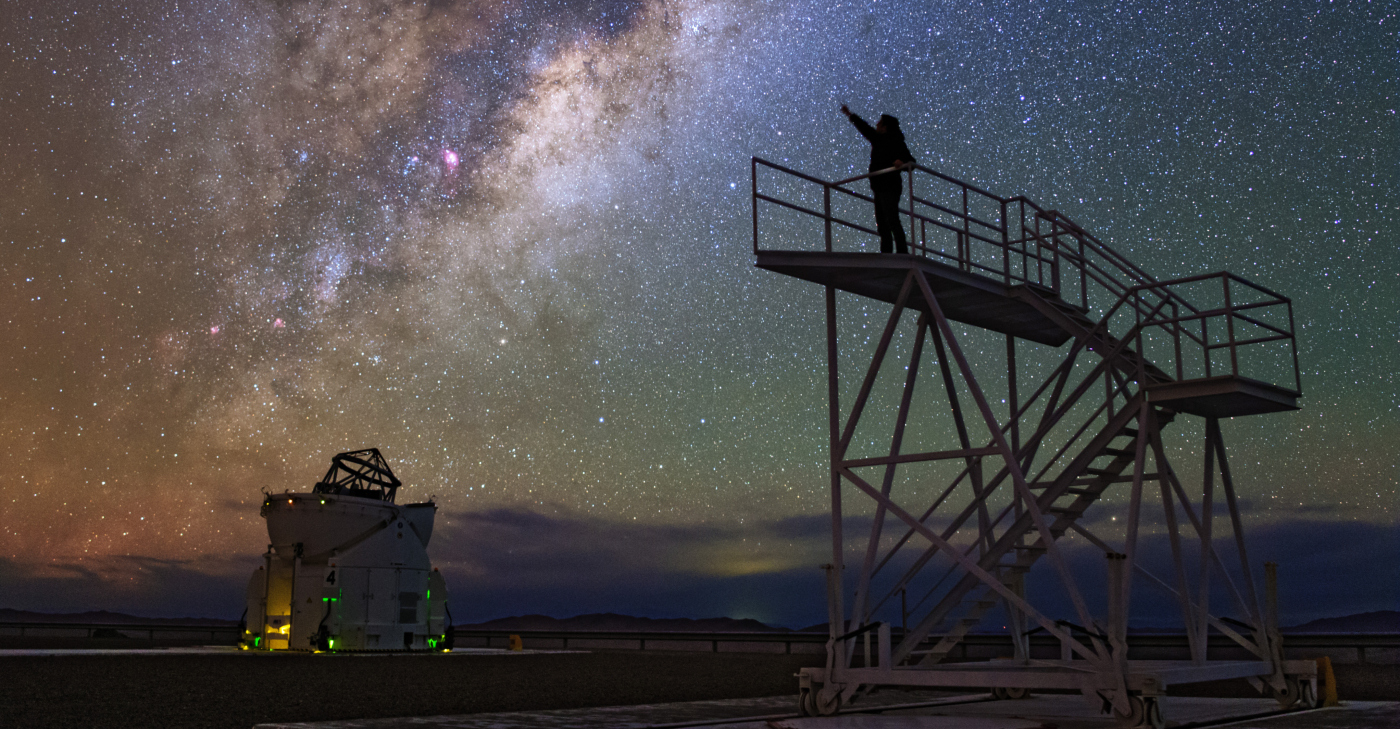
GLOBALLY SCIENTIFIC
As mentioned, Chile has some of the largest and most important astronomic observatories on Earth, such as the ALMA Observatory’s Radio-telescope (Atacama Large Millimeter Array), the Paranal Observatory , and soon, Paranal’s newest ELT (Extremely Large Telescope) which will turn this astronomic center into the World’s largest optic astronomic center.
Significant public interest in learning and appreciating the mysteries of the Universe has motivated the corresponding government organisms to promote the development and expansion of Astro-tourism in Chile. Furthermore, an ethnic factor has also been embraced into the process, seeking to mix astronomy with history and use this instance to teach about the cosmovision of our Native, Pre-Columbian, communities.
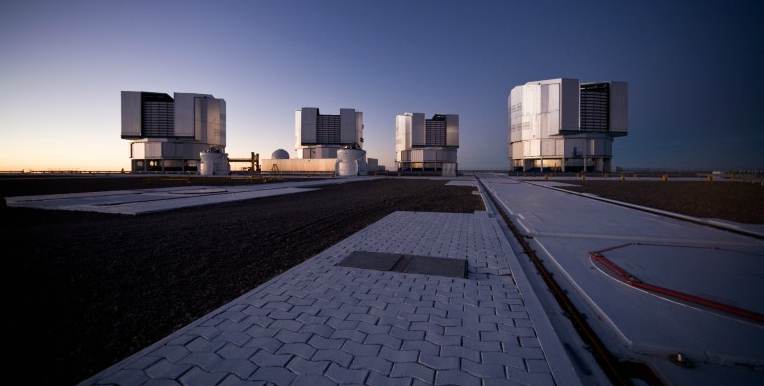
For example, in Atacama there’s a proposition to promote “Ethnic-Astro-tourism” or also called, Archeological Astronomy, which helps people today to understand the Andean Cosmo-vision of the past, developed centuries ago by the “Likan Antay” or Atacama people, whose lives were very much influenced by the stars, impacting even the social structure of the Andean people.
In fact, tour guides in Atacama have been educated in this scientific field in order to organize a number of Ethnic-Astrotourism programs and many of them offer Astro-Photography guided tours as well, with experienced photographers. They invite you to capture the most Amazing images of the Galaxy.
A FREE TOUR
To visit the Observatories during the day is free, with a limited capacity for bookings, which is why astro-tourism in Chile is an attraction that should be planned with at least a month in advance.
Some of the scientific centers that open their doors to the public are: the Paranal Observatory , located 130 kms South of Antofagasta, it has the most advanced optic instruments of the World.
The ALMA Observatory, located on the road to San Pedro de Atacama, is 5000 mts above sea level (16400 feet above sea level), and due to security reasons, it only offers tours in controlled rooms and facilities where astronomers work and live. La Silla Observatory is located towards the outskirts of the Atacama Region, and they are open offer visits every Saturday.
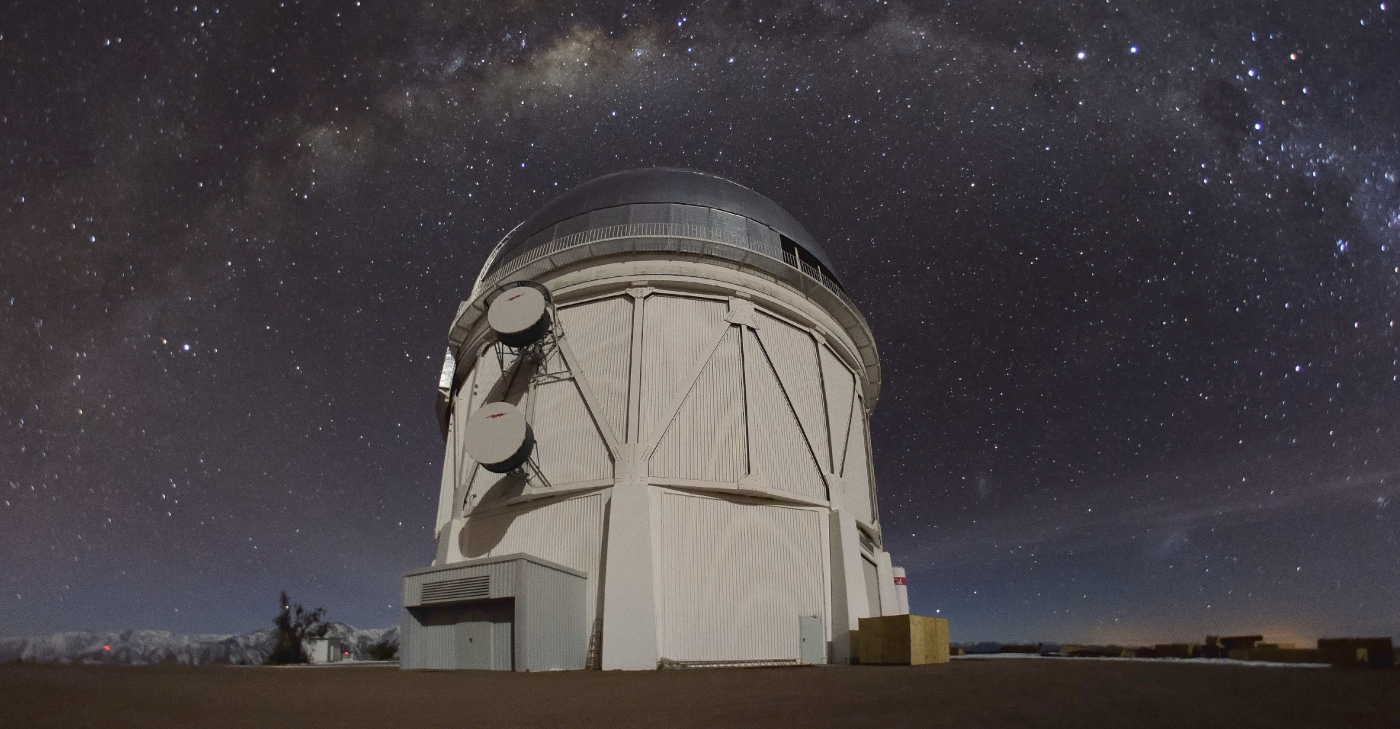
In Coquimbo, region that has been nicknamed “the Star Capital”, is where Cerro Tololo is located. This Inter-American Observatory is in the Elqui Valley and nearby there’s another one, the Gemini Observatory , that offers tours every Fridays year-round.
SPECIAL INTEREST
If you are looking to enjoy the starry sky and learn about the Milky Way, there is a wide range of tours offering Astro-tourism for experts and amateurs, which also include Presentations and horse-riding. There are many different modes and price ranges, but they all have in common a warm welcoming and didactic immersion into astronomy, preceding the open sky experience.
We start the Astronomic route close to Antofagasta at the Paniri Caur Observatory , located in Chiu Chiu towards Calama. Here Astronomy is complemented with the archeology of the place. The tour considers an introductory talk, classic and Andean constellation gazing and the use of 14- inch telescopes.
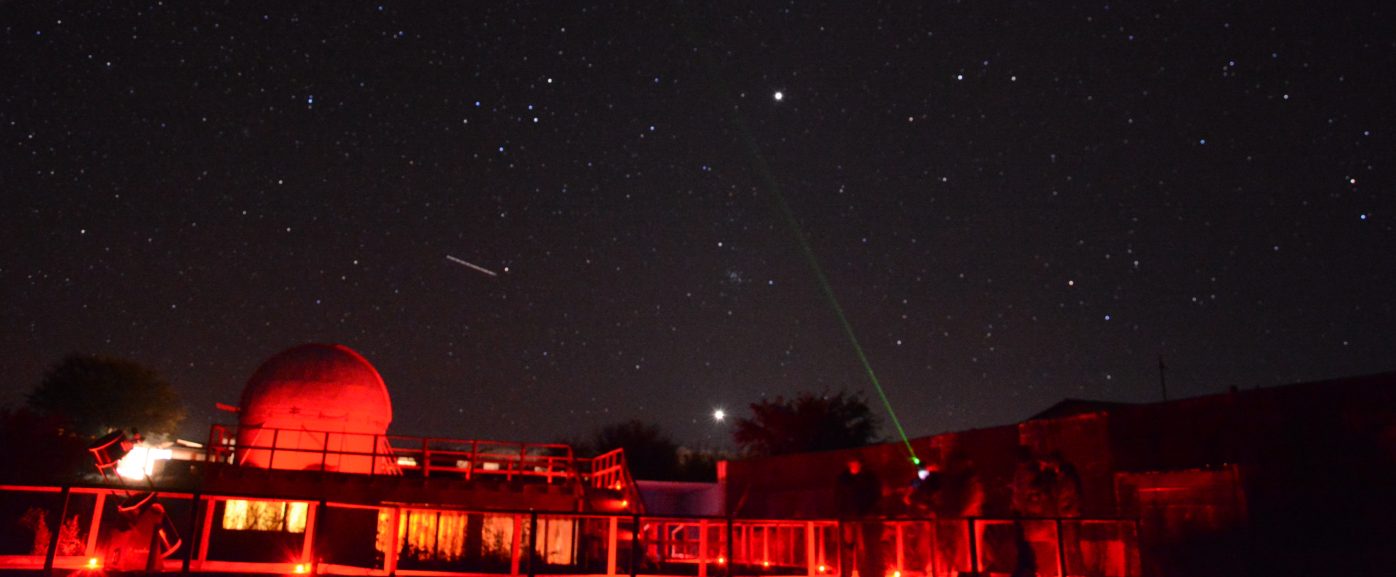
The Alarkapin Observatory is located in San Pedro de Atacama and offers different activities besides telescope observation, such as night walks with expert lessons, during solstices and equinoxes.
The Inca de Oro Observatory , located 100 km from Copiapó, offers visits from Monday to Saturday, starting at 9pm. Around the area you can book horse riding and make Group observations.
CLEAR SKIES
Northwest of Vicuña, in the middle of the amazing skies of the Elqui Valley you can find our Pioneer in Astro-tourism: The Mamalluca Observatory . The tour at this giant of Chilean Astro-tourism includes transportation, an introductory talk, plain-sight observation and big and small telescopes.
Under the same clear sky is the Pangue Observatory with the biggest public telescope in the country that is 25 inches. Other ones include the Cancana in Cochiguaz, the Cielo Sur in Pisco del Elqui and the Cerro Mayu Observatory, 25 km from La Serena.
The Collowara Observatory , close to Andacollo, is one of the country’s most modern research centers. It has different telescopes, conference rooms with audiovisual material. Also, different activities are carried out, like theme dinners and horse riding in the area. The Cruz del Sur Observatory, located south of La Serena, has four domes with 12 to 16- inch telescopes to watch different areas of the sky.
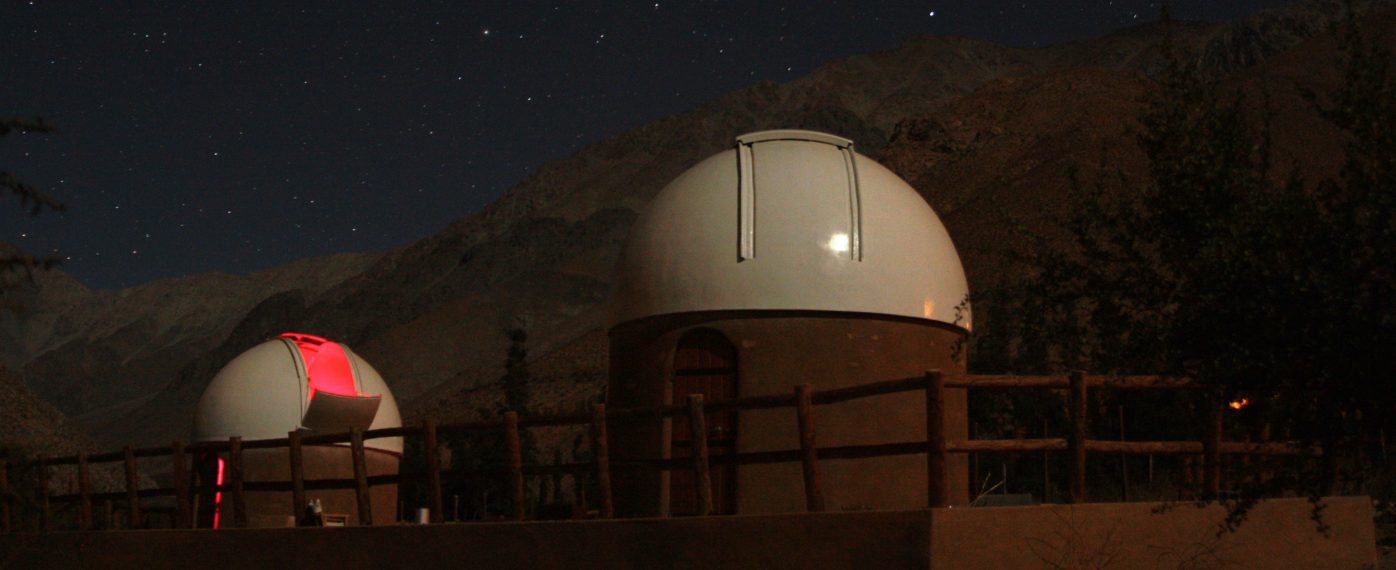
OBSERVATION IN THE CAPITAL
Santiago is not left out of the Astro-tourism in Chile and has an interesting number of activities to discover the secrets hidden in the stars, such as the Andean Astronomic Observatory .
On the road to the Chilean capital’s sky centers, who will get an introduction to astronomy, with talks, observation with binoculars, different types of telescopes and astro-photography demos.
The National Astronomic Observatory located on Calán Hill has guided visits from September to May, except for February, as long as the weather conditions allow them.
In the Cajón del Maipo you can find the Roan Jasé Observatory that offers astronomic tours, day (solar) and night observations with different size telescopes. This tour combines classic astronomy with Mapuche Cosmo vision elements.
In the same area you can find the Pailalén Astronomic Observatory that offers tours including talks, star recognition and telescope observation. Besides, it has a restaurant, a café and wine tasting.
EDUCATION WITH THE STARS
In the Aconcagua Valley you can find the Pocuro Astronomic Observatory that has the largest telescope in the area, donated by the Bochum University and the La Silla Observatory.
Close to San Vicente de Tagua Tagua, the Tagua Tagua Astronomic Center offers astronomic talks and observation with telescopes of different sizes, together with wine tasting and gastronomic experiences.
Finally, on the shore of the Lanalhue Lake in the South of Chile we can find the Yepun Astronomic Observatory, in the southmost tip of the country. Here there are astronomic observation sessions throughout the year but visits are confirmed a week in advance because they depend on weather conditions.
As you can see, Astro-tourism in Chile is abundant, in places that will give visitors a unique experience, that fosters the term “Sky culture”, and offers everyone the chance to get closer to Outer space and the infinite Cosmos.
If you liked this article, please share it:
Articles that may interest you
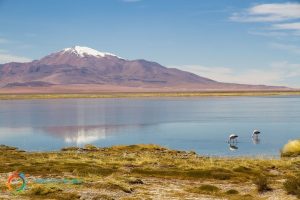
Space Star Tours
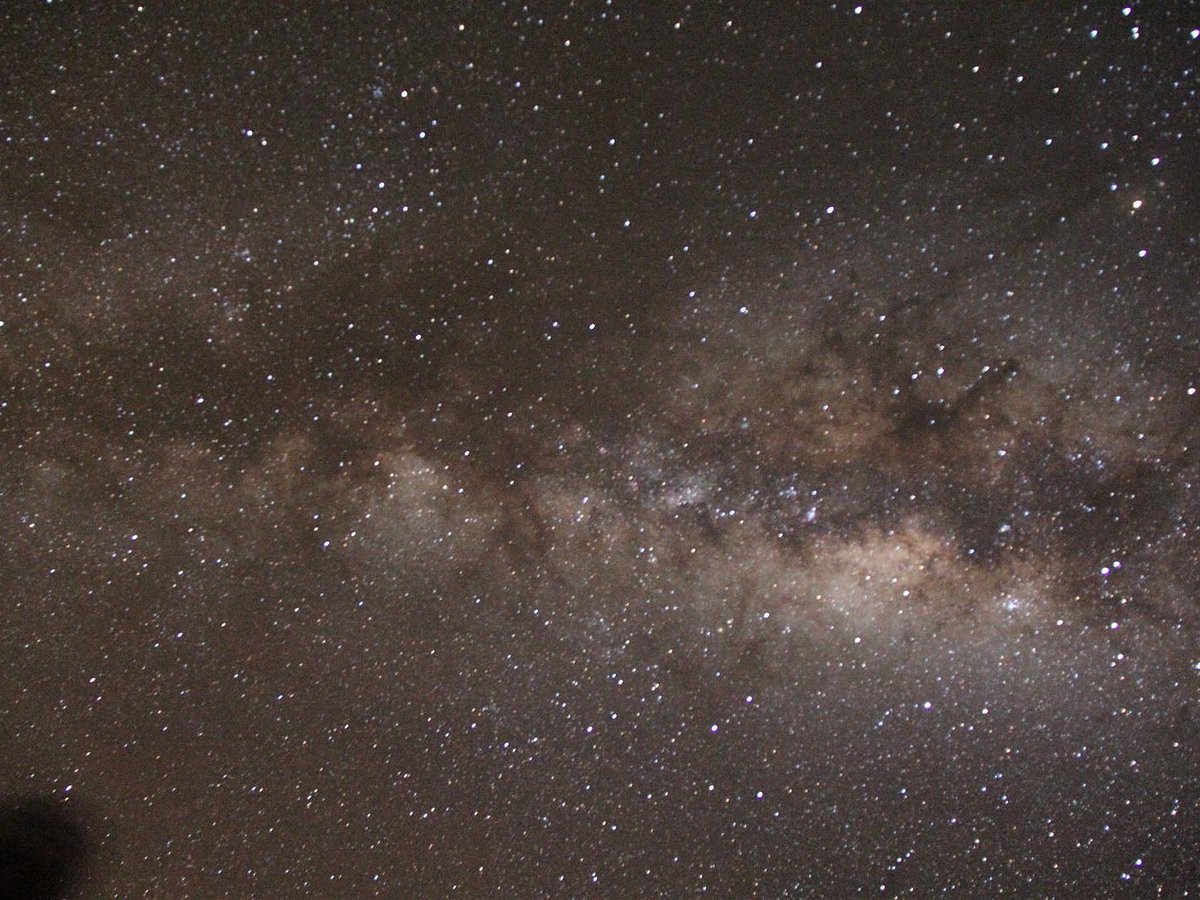
- See all photos

Similar Experiences

Most Recent: Reviews ordered by most recent publish date in descending order.
Detailed Reviews: Reviews ordered by recency and descriptiveness of user-identified themes such as wait time, length of visit, general tips, and location information.
Space Star Tours - All You Need to Know BEFORE You Go (2024)
- USA/Canada 1-888-232-3813
- Walking & Hiking
- Wildlife and Nature
- Multiactivity
- Photo Safari
- Excepcional Journey
- Water Adventures
- Food & Wine
- City Escapes
- Winter Adventures
- EcoCamp Patagonia
- Argentine Patagonia
- Chilean Patagonia
- Atacama Desert
- Santiago and Central Valley
- Easter Island
- Lake District
- Multidestination
- Northwest Argentina
- Uyuni Salt Flats, Bolivia
- For Families
- For Couples
- For Friends
- For Solo Travelers
- Central Valley
- Wildlife & Nature
- News & Awards
- Sustainability
- Outdoor Sports
- Yoga & Wellness

Watch the Skies: Stargazing and Astronomy in the Atacama Desert
Posts by tag.
- Patagonia (74)
- Inspire (50)
- Wildlife & Nature (28)
- News & Awards (25)
- Food & Wine (20)
- Outdoor Sports (20)
- Central Valley (16)
- Culture (14)
- Atacama Desert (13)
- Sustainability (8)
- Lake District (5)
- Yoga & Wellness (5)
- Easter Island (3)
- Bolivia (1)
When poet Pablo Neruda wrote about the bright stars and night sky of his beloved Chile, he used simple but strong phrases, evoking color and movement. With a few words - “... the night sky is full of stars, and the stars, blue, shiver in the distance..." - he captured a sense of peaceful vastness, coupled with both fascination and helplessness at the grandness of the night sky.
We can’t know for sure what night sky he was looking at when he wrote these stanzas for his famous One Hundred Love Sonnets - maybe an ebony sky sprinkled with silver stars twinkling over the ocean at his Isla Negra home, maybe a night sky clouded with haze amid the bustling of cosmopolitan Santiago - but reading his words today, they bring to mind the impossibly clear, forever brilliant starry skies over the Atacama Desert.
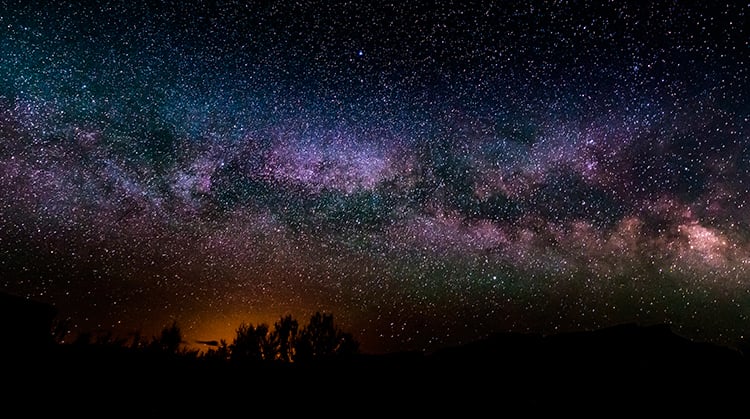
Sprawled over the altiplano of northern Chile, the Atacama Desert's 600 miles are home to an otherworldly mix of the bizarre and the beautiful. Featuring out-of-this-world vistas like Valle de la Luna (Moon Valley) , and Valle de Marte (Mars Valley) , it is one of Chile’s top travel destinations, both for its diverse landscapes and cultural allure. Visitors can be awed by the steaming geysers of the Tatio Geyser field , observe wild flamingos at the shimmering Chaxa Lagoon , play with optical illusions on endless, crunchy salt flats, hike through jagged valleys of rock and sand, and immerse themselves in the history and culture of this ancient region. The Martian-esque landscapes have even served as shooting locations for outer space sequences in films such as Space Odyssey: Voyage to the Planets .
Recently, over the last ten years, the Atacama has seen a boom in “ astro-tourism ,” drawing avid stargazers, astronomy enthusiasts, and astro-photographers from around the world who seek out unpolluted skies for the best views of distant galaxies, clusters of shining stars, and the nebulous Milky Way. And the Atacama is now one of their top destinations.
Why is the Atacama one of the best places on Earth for stargazing? The desert has a lucky combination of unique atmospheric conditions to thank for that.
Firstly, the Atacama Desert is located in the nosebleed section of Chile - as in, it's at high altitude . San Pedro, the central tourism hub where most hotels and tourist companies are located and the closest town to top attractions like the Tatio Geysers and Valle de La Luna, sits at roughly 2,407 meters above sea level , high enough for some people to experience mild symptoms of altitude sickness. This high altitude brings the stars just that much closer to Earth, making them clearer and easier to observe. Secondly, it’s the driest non-polar desert on Earth , receiving less than 0.6 inches of rain a year. The lack of moisture also contributes to a lack of cloud cover. Lastly, and perhaps most importantly, the Atacama’s small human population and isolation results in a blissful lack of radio interference and almost no light pollution .
All these elements combine to make the Atacama heaven on Earth for watchers of the skies.
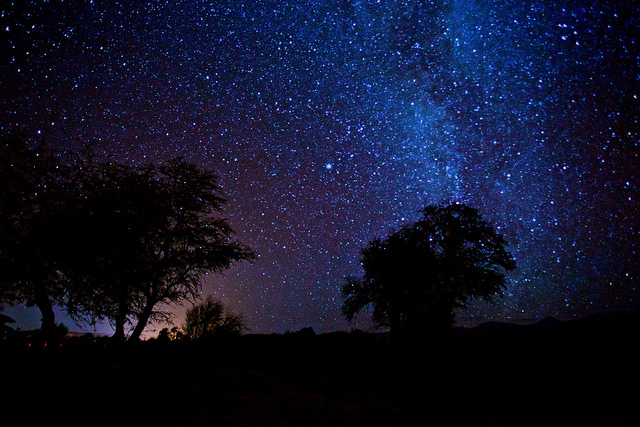
Observatories of the Atacama Desert
Some of the most technically advanced and scientifically renowned observatories in the world are located in the Atacama Desert, taking advantage of the altitude, aridity, and almost non-existent light pollution to scan deep space and investigate the mysteries of the universe.
Sitting perched on top of a hill, the Paranal Observatory is arguably the most famous of the lot, and holds tours for the public to see the facilities. Home to the Very Large Telescope , the Paranal has been instrumental in such groundbreaking observations as tracking the movements of planets around a black hole, and taking the first ever picture of an exoplanet.
But the uncontested giant of Atacama’s observatories is ALMA . Meaning “soul” in Spanish, the ALMA (Atacama Large Millimeter/submillimeter Array) is the largest and most ambitious land observatory ever built , a $1.5 billion, multinational project drawing astronomers and scientists from all over the world to use its immense 66 antennae telescope, which is more powerful than the Hubble telescope . Public tours are extremely popular, and generally need to be booked a month or so in advance. But don’t expect to get too close to ALMA’s legendary telescope. Located at 5,000 meters above sea level, the risk of altitude sickness and the delicateness of the equipment make the site off-limits. But the thrill of seeing one of the most powerful telescopes ever built is best enjoyed from a distance, where the scale of the project can be truly appreciated.
But it’s not just the sky that’s of interest to science. NASA has also used the sandy, rocky terrain to test Mars rovers being prepped for space travel.
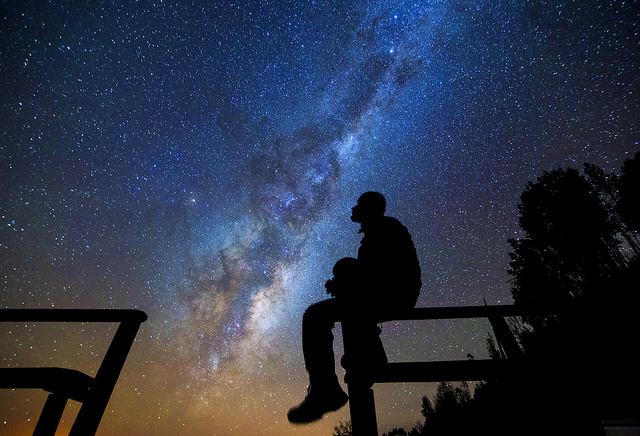
Where and How To Watch the Skies
In addition to observatories offering day tours, most hotels and tourism companies in San Pedro de Atacama offer year-round stargazing tours and excursions led by local astronomy experts with top notch equipment or access to smaller, tourism-oriented observatories.
One of the best ways to marvel at and learn about the Atacama’s night skies is over an outdoor dinner with a local astronomy expert , who offers an accompanying lecture during dinner and points out planets, constellations, and other celestial objects.
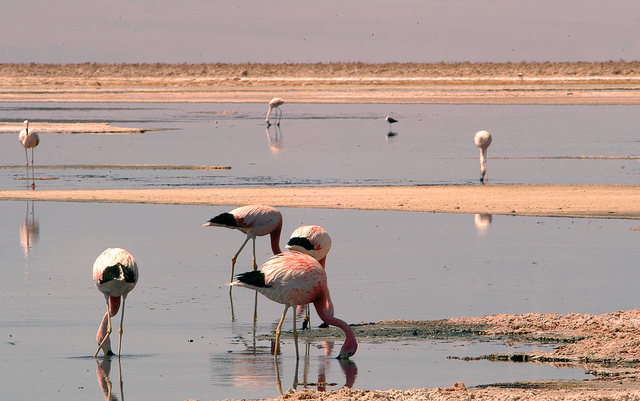
Atacama Stargazing Tips
- Before planning a trip to the Atacama for stargazing, be sure to check this year’s lunar calendar , in case there are any astronomical events you’d like to observe, like meteor showers or eclipses.
- Don't go stargazing during a full moon! At peak fullness, the brightness of a full moon over a desert landscape is a hauntingly beautiful image, but washes out the night sky.
- Invest in a star chart or stargazing apps to find constellations and planets. If you’re attending a tour, the guide will be able to point these out for you, but it’s also fun to try and puzzle out the night sky on your own!
Want to spend a night under the Atacama’s starry skies and learn about the wonders of the night sky? Click here to learn more about our Atacama tours .
Subscribe to our Newsletter
Related posts.
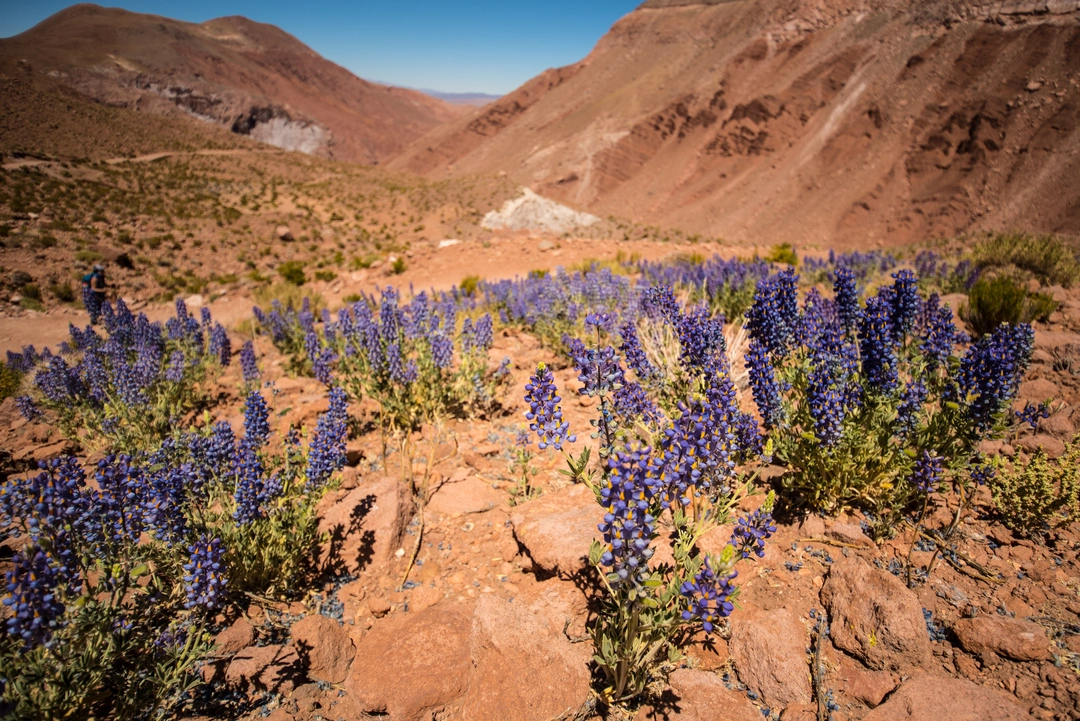
Chile Announces the Creation of Desierto Florido national park
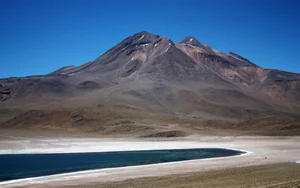
Atacama Must #3: High Altitude Lagoons + Other Desert Tales

Atacama Must #2: Atacama Food Stops Not to Miss

The Chilean Way
Want to learn more about the beautiful country of Chile? Download our insider’s guide to learn all the best travel tips and tricks.

- TERMS & CONDITIONS
- PRIVACY POLICY
Destination
- Multi Destination
- Salta Argentina
Experiences
- Multi-activity
- Exceptional Journeys
SOCIAL NETWORKS

Updated October 4th, 2022
Dear Traveler,
We are very happy to announce that there are currently no travel restrictions in Chile. Together with the above mentioned, it is mandatory to comply with the following requirements:
- You only have to present the vaccination certificate issued in your country when boarding to Chile. Those who do not have their vaccinations must present a negative result in a PCR test dated less than 48 hours from departure to enter Chile. Those who are under 18 years of age do not have any requirements to enter Chile
- A negative PCR upon arrival is not compulsory any more but diagnostic tests will be carried out randomly at the entry point to Chile. Confirmed cases shall be isolated according to the general health regulations.
- Medical insurance covering any expenses caused by COVID-19 is not compulsory any more
- The use of a face mask is voluntary
In case you have any questions, we will be happy to help you!
The Team at Cascada Expediciones & EcoCamp Patagonia
- International edition
- Australia edition
- Europe edition

State-of-the-art telescope in Chile to offer best view yet of universe
The futuristic $1.9bn Vera C Rubin Observatory took nine years to build and will survey the night sky in unprecedented detail
After nine years of construction, a state-of-the-art telescope connected to the world’s largest camera is set to change our understanding of astronomy.
Perched on top of a barren mountaintop in the arid Chilean desert region of Coquimbo, the Vera C Rubin Observatory looks out of this world, quite literally.
With a slick, futuristic frame lodged into the mountain’s groove on Cerro Pachón, the observatory is characterised by a distinctively compact, revolving dome-like shape that splinters into a myriad of angles.
The unusual, isolated structure is the heart of a $1.9bn project that will begin to map the sky in early 2025.
“It’s a very special telescope, different from others because it will take a survey of the night sky. It will move a lot,” said Jacques Sebag, the site’s assembly integration and verification manager.
Using a laser pointer, Sebag points out the width of the telescope’s 8.4-metre diameter mirror, fitted with a state-of-the-art 3,200-megapixel camera.
It is designed to capture an unprecedented amount of astronomical data in a 10-year survey called the LSST (Legacy Survey of Space and Time).
“Before this, telescopes saw small areas of the space, looking at very specific information for a very specific problem, but this is like a lighthouse,” he said, his hands spreading out to convey the vast celestial canopy. “It [illuminates] different parts of the sky. It is the fastest-moving telescope ever built.”
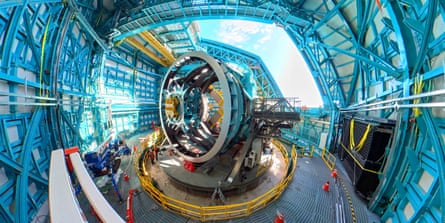
The telescope is distinctively squat and compact in design, allowing it to constantly shift and observe changes, registering what astronomers call “the transient sky”.
Every night it will detect 10m events, ranging from asteroid movement to supernova explosions.
“It’s a very rich dataset, it has something for almost everybody in astronomy,” said Frossie Economou, the site’s technical manager for data management.
“We’ll answer questions about the universe from our local neighbourhood – the solar system – to the creation of time, out there in the far reaches.”
Construction of the observatory, which is named after the North American astronomer who proved the existence of dark matter, began in 2015.
The project is principally envisioned to address uncertainties about dark matter and dark energy, which make up more than 70% of the universe.
Chile is home to a number of the world’s most important astronomical centres. The altitude of the Andean mountains that frame the country, and the lack of light pollution in the sparsely populated desert areas, make for ideal skygazing conditions. The Rubin site enjoys an average of 256 clear nights a year.
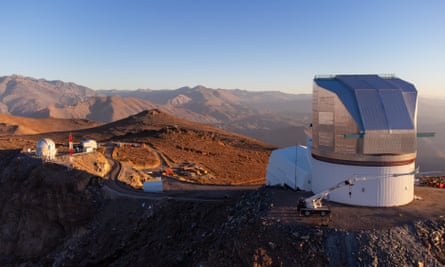
With the completion of the Rubin project, Chile will become the leading destination of astronomical observation, generating about 70% of data seen from Earth by 2025 .
Steve Heathcote is the director of Cerro Tololo, a neighbouring observatory that has conducted studies that serve as a precursor for Rubin.
The telescopes at Cerro Tololo were integral to the discovery of the universe’s accelerated expansion, work that won the Nobel prize for astrophysics in 2011.
Heathcote is hopeful that, once again, Chilean skies will help unlock more of the mysteries surrounding the creation of our universe.
“There’s enough uncertainty in current measurements that you could fit in something different,” he explained, referring to our understanding of the big bang and universe expansion. “I think with Rubin, they’ll be able to get the errors down to the point where you can be sure.
“It could challenge Einstein’s theory of relativity. It could challenge fundamental things in physics.”
Over 10 years, the LSST will generate a staggering 60 petabytes (60,000,000 gigabytes) of data through 2m images. The UK is responsible for processing about 25% of this data.
Aprajita Verma is based at the University of Oxford and is Rubin’s international program coordinator. She refers to the LSST as “the greatest movie of the sky that mankind has ever made”.
“I find it overwhelming. It really will revolutionise our view of survey astronomy and understanding of the billions of objects that we’re gonna see.”

The excitement of the project is rippling through the global astronomical community but is equally felt locally.
Claudia Llanquitruf has been involved in the construction of the site’s revolving dome since 2019.
She manages a company that is usually tasked with mining projects, based in the city of La Serena, about two hours from Rubin.
Llanquitruf is in awe of the site.
“I know what this project means, and all the studies it’s going to generate. It’s an honour to work here.”
Most viewed

Astronomy, cosmology and space
Tours which give deep insight into what is beyond our planet and our efforts, past, present and future, to explore it.
Most Popular
Renaissance astronomy in kepler's prague: czech republic.
Discover the secrets of Renaissance period astronomers Kepler and Brahe in Prague, the stunning city of a hundred spires, and stargaze at the Stefanik Observatory.
15 September 2024
Short Break
The science of deep time: brecon beacons (bannau brycheiniog) wales.
Explore the concept of deep time with engaging talks and walking seminars in a gothic castle, underground caves and the stunning landscapes of the Brecon Beacons.
9 September 2024
The world capital of astronomy: Chile
Visit world-leading observatories, gain hands-on experiences and stargaze at several sites with exceptionally clear skies. With astronomer Martin Griffiths.
27 March 2025

Mysteries of the universe: Cheshire, England
Discover the riddles of the cosmos and hear from leading scientists who are deepening our understanding of the universe and everything in it.
30 August 2024
Science of astronomy and ice: Sweden
Join a unique expedition to the remote wilderness region of Northern Sweden, to unearth the science of astronomy and ice, whilst staying at the worlds largest Icehotel.
Astronomy and volcanoes in the Canary Islands: Spain
Visit an array of telescopes, take part in expert-led stargazing and explore the volcanic landscapes at multiple sites across the islands of Tenerife and La Palma.
28 November 2024
Total solar eclipse tours and cruises 2026 and 2027
We are working on highly immersive tours and cruises, from which you can experience the total solar eclipses in 2026 and 2027. Register now, to hear our plans first.
- Share full article

A Giant Telescope Grows in Chile
These days it takes a generation to build a great astronomical observatory. A new one is taking shape in the Atacama Desert.
The Las Campanas Observatory on a ridge in the Chilean Andes, and the site of the future Giant Magellan Telescope. Credit...
Supported by
By Dennis Overbye
Photographs by Marcos Zegers
- Published April 18, 2023 Updated April 19, 2023
LAS CAMPANAS OBSERVATORY, Chile — To walk among the observatory domes of the Atacama Desert is to brush your hair with the stars.
The Atacama, on a plateau high in the Chilean Andes, is one of the driest and darkest places in the world. During the day one can see to Bolivia, far to the east, where clouds billow into thunderstorms that will never moisten this region. At night, calm, unruffled winds off the Pacific Ocean produce some of the most exquisite stargazing conditions on Earth.
One evening in late January the sky was so thick with stars that the bones of the constellations blurred into the background. The Milky Way, our home galaxy, was rolling straight overhead, and the Large and Small Magellanic Clouds, satellite galaxies of our own, floated alongside like ghosts. The Southern Cross, that icon of adventure and romance, loomed unmistakably above the southern horizon.
In the last half-century, astronomers from around the world have flocked to Chile and its silky skies, and now many of the largest telescopes on Earth have taken root along a sort of observatory alley that runs north-south for some 800 miles along the edge of the Atacama.
The residents include the Very Large Telescope, composed of four telescopes, each more than eight meters (27 feet) in diameter, and built by an international collaboration called the European Southern Observatory. The Vera C. Rubin Observatory, another eight-meter telescope, is set to start operating next year, mapping the entire sky every three days.
(The ability of a telescope to harvest light from distant stars depends roughly on the area of its primary mirror. The Palomar Telescope in Southern California, an instrument that ruled astronomy into the 1990s, was five meters, or 200 inches, in diameter.)

Las Campanas Observatory, whose telescopes and offices are strung along a steep ridge on Cerro Las Campanas at an altitude of 8,500 feet, was one of the early adopters to the Atacama sky. Taking pride of place along the ridge today are two innovative telescopes, the Twin Magellans, each with curved sweeps of aluminized glass 6.5 meters in diameter, side by side in separate enclosures.
But these are just a beginning. Las Campanas is an outpost of the Carnegie Observatories, based in Pasadena, Calif., which in turn is owned by the Carnegie Institution for Science, based in Washington. The Carnegie Institution is a founder of and a driving force behind a consortium of 13 universities and institutions that aims to build the Giant Magellan Telescope, or G.M.T., a multibillion-dollar instrument more powerful than any existing ground-based telescope.
When completed, the telescope will have seven mirrors, each eight meters in diameter, that together will act as a 22-meter-diameter telescope, roughly 20 times as powerful as Palomar. The G.M.T. will be built at the top of Cerro Las Campanas, two miles from the domes of the Carnegie’s existing telescopes.
Equally gargantuan telescopes are being planned and built on mountaintops elsewhere around the world. With these cathedrals of glass, steel and technology, astronomers hope to capture their first detailed images of faraway planets, the next important step in the quest to determine whether the cosmos beyond Earth is habitable, or perhaps even inhabited.
Going South

The Carnegie Institution for Science was founded by Andrew Carnegie in 1902. It prides itself on its history in science and astronomy, said Eric D. Isaacs, a physicist and the institution’s president. In 1929 the astronomer Edwin Hubble, using Carnegie telescopes on Mount Wilson, in Pasadena, discovered that the universe was expanding. In 1978 another Carnegie astronomer, Vera Rubin, confirmed that the stars and galaxies were swathed in clouds of a mysterious dark matter, which scientists still do not understand.
The Carnegie began eyeing Chilean skies in the 1960s as a potential site for a southern twin to the 200-inch Hale Telescope, which was completed on Palomar Mountain in 1948 in partnership with the California Institute of Technology. Twenty years later, the Carnegie bought 84 square miles in the Atacama region for 30 cents an acre. The National Science Foundation was establishing an outpost farther south at Cerro Tololo, and the European Southern Observatory, a European organization, had stationed telescopes on La Silla, a peak visible from Las Campanas.
“It was just a genius move,” Dr. Isaacs said. “This plot of land is wide open for ideas.”
The first telescope on Las Campanas, a one-meter-wide reflector called the Swope Telescope, went into action in 1969. It was named after Henrietta H. Swope , an American astronomer and philanthropist who is credited with figuring out a way to measure the distances of stars and nearby galaxies.
In 1984 Bradford A. Smith of the University of Arizona and Richard J. Terrile of the NASA Jet Propulsion Laboratory used the Swope Telescope to discover a disk of dust around the star Beta Pictoris, evidence of planet formation in action. “That was the beginning of exoplanets,” said John Mulchaey, the director of Carnegie Observatories and its branch at Las Campanas.
And in 1987, when a star in the Large Magellanic Cloud exploded as a supernova , it was first seen by the Swope and, simultaneously, with the naked eye of a Las Campanas staff member who was on a break in the parking lot.
The Lure of the Southern Cross

The accommodations along astronomy’s Route 66 range from rustic to luxurious. Researchers at the Atacama Large Millimeter Array — at 15,900 feet, it’s the world’s highest radio telescope — must wear oxygen masks to visit; the Very Large Telescope has a swimming pool. All of the observatories have a soccer pitch and compete among themselves in a tournament every year. Consensus holds that the best food in all of astronomy is to be found at the Chilean observatories.
Getting to Las Campanas entails an overnight flight to Santiago (10 hours from New York or Los Angeles); a two-hour flight north to La Serena, a coastal resort town where some of the Chilean observatories, including Las Campanas, have offices; and then a three-hour drive up into the mountains.
Dr. Mulchaey lives in Pasadena, where Carnegie Observatories is based, but he commutes to Las Campanas regularly. His trip in January was his 134th since 1994, when he first came for postdoctoral research on the mass and fate of the universe . “At one point, I estimated that I’ve spent something like 15 percent of my adult life at L.C.O.,” he said afterward in an email.
During the coronavirus pandemic, many of the observations at Las Campanas were carried out remotely. Neither Dr. Mulchaey nor Dr. Isaacs had been to the observatories since before Covid, and they were eager to get back.
“What has changed is the people,” Dr. Mulchaey said. Many of the staff members, who live down in La Serena, had retired. And too many astronomers had grown accustomed to observing from their living rooms, without the stress of the expensive and time-consuming trip to the telescope. As a result, the younger astronomers often didn’t know the telescopes or the people operating them.
“It’s important to get them back,” Dr. Mulchaey said.
Creatures of the Night
Next to the domes on Las Campanas is a cluster of cabins for visitors, staff members and researchers, who stay for a week at a time, and a lodge with a dining hall, which has a cappuccino machine.
Populating the ridge and surrounding slopes are herds of gazellelike creatures called guanacos; viscachas, marmotlike rodents with rabbity ears; burros; and hawks. The white domes of La Silla Observatory are visible to the south. Attached to the main lodge is a terrace where, at day’s end, astronomers gather to try to get a glimpse of the green flash, a rare last vestige of the sun as it disappears below the horizon, if the conditions are exactly right.
After sunset it’s lights out at the lodge, and observatory personnel will come and pull down the blinds on your cabin windows, if you haven’t done so already, to keep artificial light off the mountain and out of sensitive telescope instruments.
One night I walked over to the Swope Telescope, beneath a Milky Way so bright that it was possible to navigate the narrow trail by its light alone. Through the telescope I beheld banded Jupiter holding court with three of its glittering moons and, 160,000 light-years away in the Large Magellanic Cloud, mists of interstellar gas twining through the Tarantula Nebula.
The view at the top of Las Campanas the next morning was less immediately celestial: a cluster of construction trailers; a maze of rope barriers to keep visitors from falling off the mountain. Hawks circled a thin, metal tower that held various instruments to monitor the weather and the atmosphere.

Looking down, I teetered on the edge of a hole in the roof of the world. Concentric circular trenches, some as much as 60 feet deep, had been carved into the volcanic rock of the mountaintop, bringing to mind a pre-Columbian earthwork. This was the future home of the Giant Magellan Telescope. I asked Dr. Mulchaey what it would do that the James Webb and Hubble space telescopes could or would not.
“A lot,” he said.
For one thing, the Giant Magellan instruments were being prioritized for studying exoplanets, and would be capable of detecting rocky, Earthlike planets as far as 30 light-years away. Moreover, as technology improves over time, astronomers will be able to change and upgrade the main instruments, whereas space-based telescopes are stuck with whatever technology they carried at launch.
In a briefing down in one of the construction trailers, Oscar Contreras-Villarroel, the vice president of the Giant Magellan organization and its legal representative to the Chilean government, elaborated on the G.M.T.’s capabilities. The design includes a sophisticated adaptive-optics system to compensate for atmospheric turbulence that can blur celestial details (and make stars twinkle). And some of the mirrors will be able to adjust their shape 2,000 times a second, to keep star images crisp over a field of view two-thirds the size of a full moon. (The Webb telescope’s field of view is only one-tenth of a full moon.)
“It will be able to resolve the torch on a dime at 99 miles,” Mr. Contreras-Villarroel said.
The foundation of the Giant Magellan Telescope, which will have seven mirrors, each 8.5 meters wide.
The first of the Giant Magellan mirrors was cast in 2005 beneath the University of Arizona’s football stadium, in a rotating furnace developed by J. Roger P. Angel, an Arizona astronomer, as a way to build giant mirrors. Three of the mirrors are now completed and sit in boxes at the Tucson airport. Three more are being polished and tested. The seventh and final mirror is set to be cast this year.
Depending on funding, the telescope could begin operations in 2030, Dr. Isaacs said in an email. “As soon as we have four mirrors, we will start collecting photons,” he wrote. “This is first light. We will be able to start early science. Construction is complete with seven mirrors and we go into regular operations.”
The peak of Las Campanas was blasted flat in 2012 to make room for the telescope, which will be almost as big as a football stadium and more than 22 stories high.
Miguel Roth, a former director of Las Campanas, led an up-close tour of the foundation. It had taken nine months to excavate, at times by hand, he said, to avoid using explosives that might fracture the underlying rock. Giant ball bearings will insulate the telescope from earthquakes. The telescope building, a giant rotating cylinder, has been designed with a system of vents and windscreens to keep the temperature inside constant. Moreover, all heat producing machinery will be underground and downstream from the prevailing wind, thwarting thermal air currents that could affect the sensitive mirrors.
“The telescope is to be one with the mountain,” Dr. Roth said. “We’ve got one of the best sites in the world, if we don’t screw it up.”
Cosmic Company
Two decades ago, the Giant Magellan was one of three efforts hatched by competing groups of astronomers and institutions to create a new generation of Brobdingnagian telescopes unparalleled in the ability to gather starlight and pierce the voids of the night sky.
In Hawaii, an American-led collaboration is trying to build the Thirty Meter Telescope atop Mauna Kea but has encountered opposition from native Hawaiian activists. And farther north in the Atacama, the European Southern Observatory is set to build the European Extremely Large Telescope by the end of the decade. It will be the biggest of three, with a composite mirror 39 meters across.
Neither the Giant Magellan nor the Thirty Meter Telescope has yet raised enough money — $2.54 billion and $3.7 billion — to fulfill its celestial dreams. Completion will depend on the generosity of the National Science Foundation, which traditionally supports ground-based astronomy in the United States, and ultimately Congress.

Robert N. Shelton, president of the Giant Magellan Telescope Organization, said he was confident that its day would come. “When complete, the Giant Magellan Telescope will be one of the largest public-private funded science projects in history,” he said. “Any delay in resources will extend the time to complete our project, but we remain committed to the success of the telescope.”
As I stared down into the rocky eye on top of Las Campanas, I tried to imagine what the Giant Magellan and its brethren would reveal about our mysterious cosmos, and which lucky astronomers would reap the knowledge.
“Not us,” Dr. Mulchaey said.
Nowadays it takes a generation to build a scientific instrument as majestic as a telescope or a new particle collider. Already the keys to the cosmos are passing into the hands of astronomers who may not have been born when the Giant Magellan was conceived. But dreams are what the cosmos is made of.
Dennis Overbye joined The Times in 1998, and has been a reporter since 2001. He has written two books: “Lonely Hearts of the Cosmos: The Story of the Scientific Search for the Secret of the Universe” and “Einstein in Love: A Scientific Romance.” More about Dennis Overbye
What’s Up in Space and Astronomy
Keep track of things going on in our solar system and all around the universe..
Never miss an eclipse, a meteor shower, a rocket launch or any other 2024 event that’s out of this world with our space and astronomy calendar .
A new set of computer simulations, which take into account the effects of stars moving past our solar system, has effectively made it harder to predict Earth’s future and reconstruct its past.
Dante Lauretta, the planetary scientist who led the OSIRIS-REx mission to retrieve a handful of space dust , discusses his next final frontier.
A nova named T Coronae Borealis lit up the night about 80 years ago. Astronomers say it’s expected to put on another show in the coming months.
Voyager 1, the 46-year-old first craft in interstellar space which flew by Jupiter and Saturn in its youth, may have gone dark .
Is Pluto a planet? And what is a planet, anyway? Test your knowledge here .
Advertisement

Chile has increasingly invested in developing its satellite technology . Projects such as the FASat-Delta, the successor of the FASat-Charlie; and Universidad de Chile’s Suchai satellites have showcased Chile’s growing prowess in this field. These satellites serve various purposes, including environmental monitoring, telecommunications, and educational initiatives.
Collaborations with international space agencies and organizations have further bolstered Chile’s position in space research. Partnerships with entities like NASA and the European Space Agency have facilitated knowledge exchange and technology transfer, fostering the growth of Chile’s space capabilities.
Currently there is no active civilian space agency, discussion at different levels regarding its creation on their way. For the time being the institution in charge of space affairs is the Council of Ministers for Space Development.
National Points of Contact (NPoC)
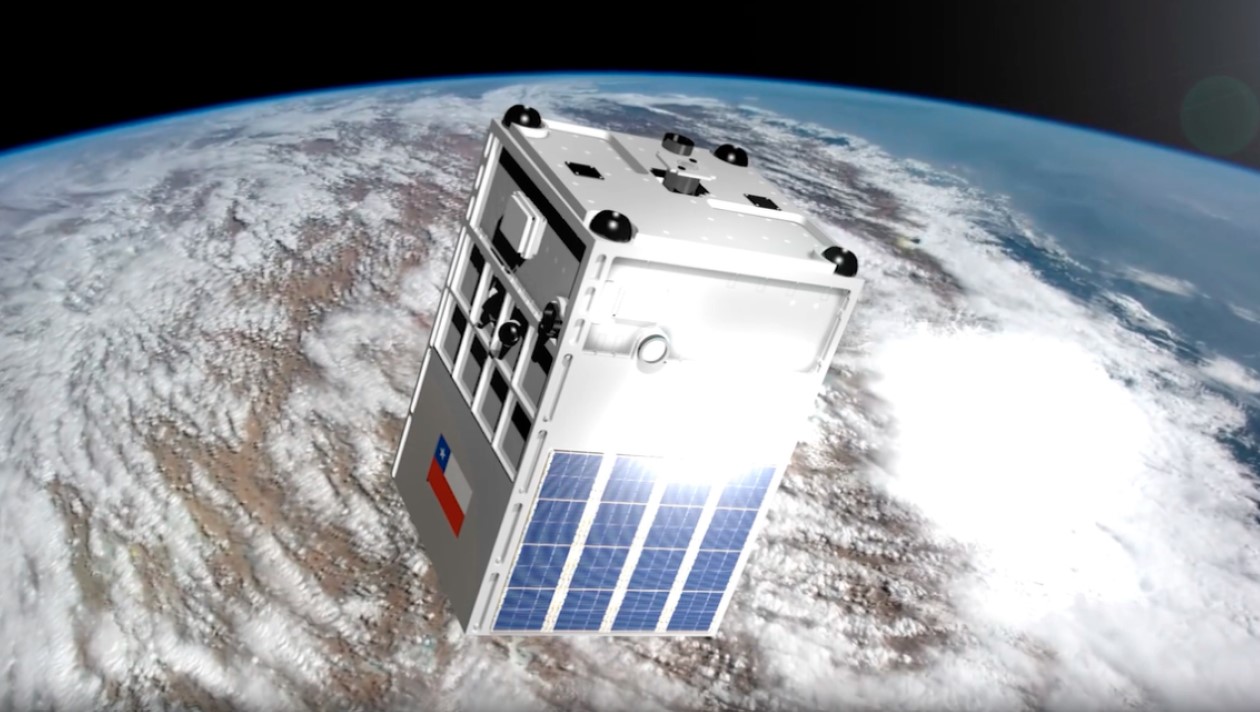
FASat-Delta Render
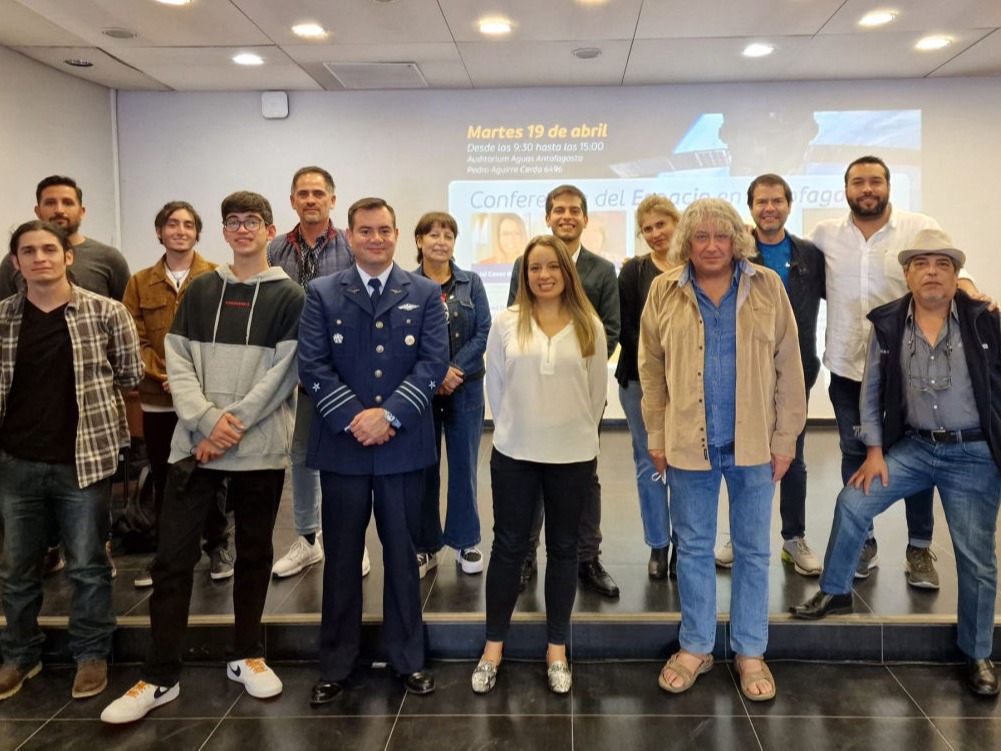
1st Space Conference in Antofagasta, organised by Sebasthian Ogalde
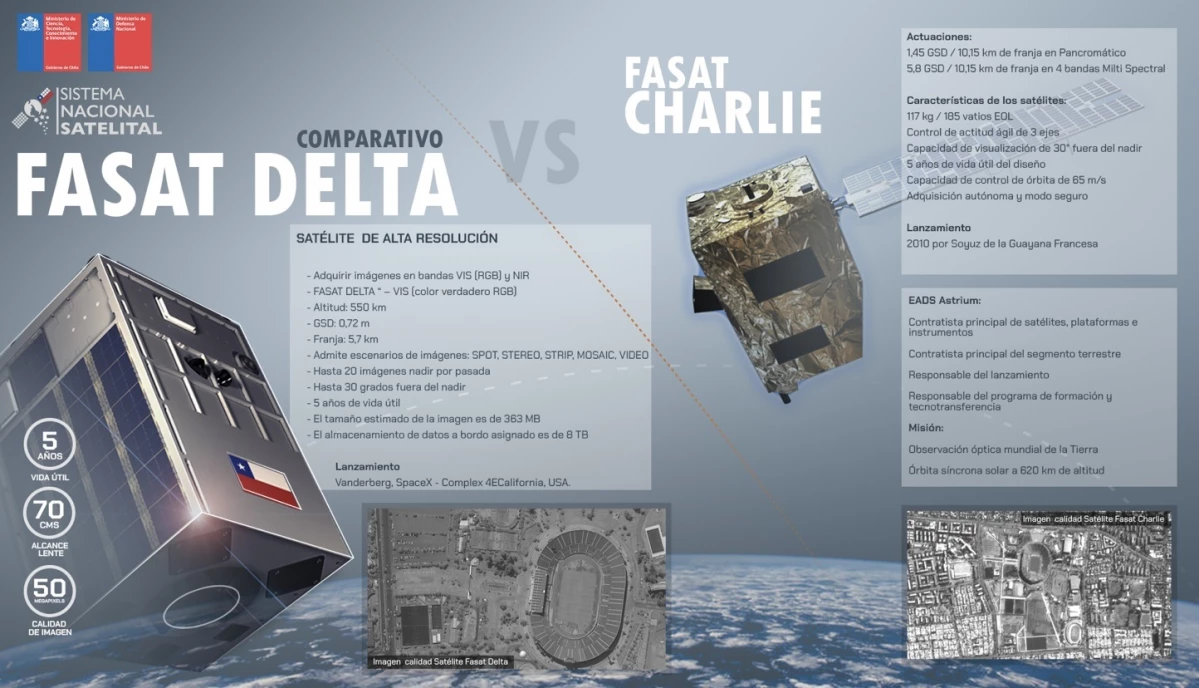
Comparison between FASat-Charlie and FASat-Delta
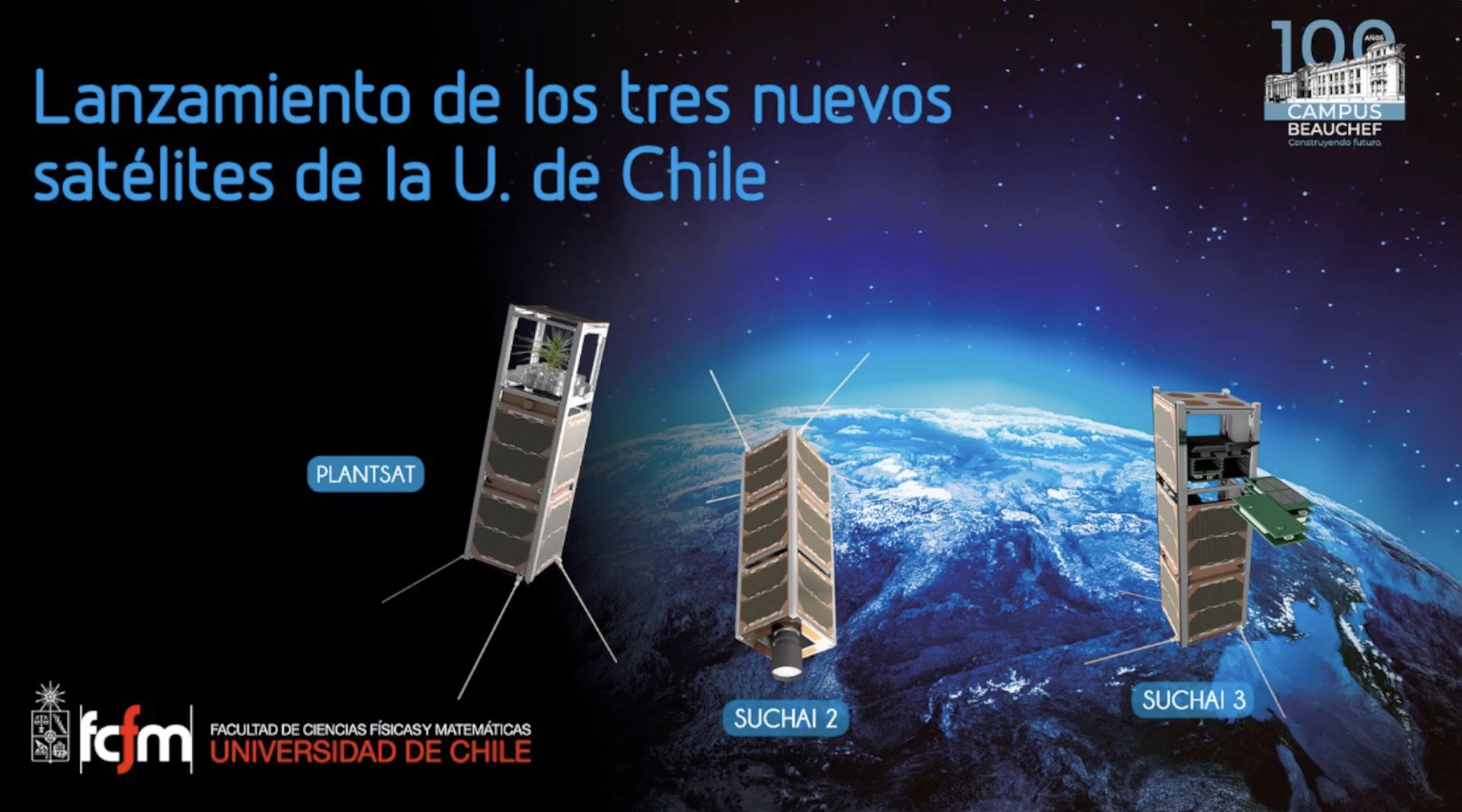
SUCHAI 2, 3, and Plantsat
Young space activities overview in chile.
In Chile most aerospace activities are focus on aeronautics and astronomy. Several amateur astronomers are spread in the country and have events throughout the year. A few parties remembering Yuri’s first space flight have been organized throughout the years.
Interesting Web Links for the Young Generation in Chile
- Council of Ministers for Space Development , website devoted to the Council as well as Executive Secretariat and Scientific technical committee activities. Provides an overview of the government lead developments in space affairs.
- Suchai 1st Chilean CubeSat , currently assembled and waiting for its ride into space throughout the year. The Space and Planetary Exploration Lab (SPEL) from the University of Chile, which lead the project, has already secured funds for developing its successors. For more information check the website http://spel.ing.uchile.cl/suchai.html
- Aerospace Students Society , association of Aerospace Engineering students from the University of Concepcion. Started in 2010, has been re-activated in 2015 after a brief pause. It carries out activities related to aerospace field, some of which are opened for general public.
- Space Operations Group (Chilean Airforce), group operating Fasat-Charlie satellite, website contains a good description of the satellite characteristics, remote sensing applications, news, and overall project description.
- Robotic & Environmental Algorithms Laboratory (REAL): Formerly involved in the development of a lunar rover as part of the GLxP Angelicvm team, focuses in “Robotic technology closer to this world and beyond”. Has developments in rovers, CubeSats and active involvement with high schools.
- Angelicum GLxP , is one of the only two Latin American teams currently involved in the Google Lunar x-Prize, that plans to put a rover on the Moon, it comprises a cooperation between Academia and Industry.
- Scholarships for MSc and PhD abroad Becas Chile . Provides a set of different scholarships for studying both abroad and in the country.
- Aerospace Engineering at University of Concepción . It is the only university in the country that gives the major in Aerospace Engineering.
- Actualidad Espacial , a free-lance website that provides with information on the ongoing Aerospace and Astronomical activities .
- Servicio Aerofotogrametrico (SAF) , is the body of the air force that deals with the distribution and purchase of images both form planes and the Chilean Satellite.
- Engineers Professional Association , organizes several engineering related activities during the year. Has a committees that organize talks related to space a few times a year.
- Atacama Solar Challenge , a solar power car race in the Atacama Desert. This car are built using a lot of aerospace technologies and material by teams of university students from all the country and from other Latin American Countries.
- National Aerospace Museum , located in Santiago has a collection of aerospace artefacts. The space exhibition counts with Moon rock samples from the Apollo time to a 1:1 model of the Fasat-Charlie satellite.
- Public visits to ALMA , Saturday and Sunday mornings.
- Magellan Aerospace Industries (MAI), small company dedicated to diffusion of astronautics and astronomy in the region of Magallanes (South end of Continental Chile).
LATEST SGAC NEWS


Pioneers of Eclipse, Astronomy and Space tours since 1979
Project Chile 2024 Annular Solar Eclipse Itineraries
Astro Trails will be observing from the remote volcanic Polynesian Island once known as Rapa Nui, the indigenous name of Easter Island. The most remote inhabited island on the planet, Easter Island is 3,700km from the coast of continental Chile and it bears witness to a unique cultural phenomenon. A society of Polynesian origin that settled there c. A.D. 300 established a powerful, imaginative and original tradition of monumental sculpture and architecture, free from any external influence - an unrivalled cultural landscape that continues to fascinate people throughout the world.
The island with almost 900 Moai statues offers the choice of a rare adventure - a remote, ancient land that few people ever reach!
Easter Island, Main Tour

LIMITED AVAILABILTY
Main tour easter island, gb£3,125 / us$3,895 per person, 8 days from 27th september 2024.
Santiago, Annular Eclipse (Easter Island),
Full day and half day Easter Island sightseeing
Extension Options
-min_JPG.jpg)
PRE TOUR EXTENSION CHILEAN PATAGONIA
Gb£5,275 / us$6,595 per person, 10 days from 18th september 2024.
Punta Arenas, Puerto Natales, Balmaceda and Serrano Glaciers , Torres del Paine, Milodon Cave, *Lake Grey, Santiago

POST TOUR EXTENSION MACHU PICCHU & CUSCO
Gb£1,475 / us$1,850 per person, 5 days from 4th october 2024.
Sacred Valley, Vistadome Train, Machu Picchu, Agua Calientes, Pisac Market, Cusco

POST TOUR EXTENSION PATAGONIAN HIGHLIGHTS
Gb£1,895 / us$2,395 per person.
Puerto Natales, Torres del Paine, Milodon Cave, Balmaceda and Serrano Glaciers, Santiago

POST TOUR EXTENSION PARACAS & NAZCA LINES
Gb£1,125 / us$1,395 per person, 4 days from 4th october 2024.
Lima, Paracas, Nazca Lines flight,
Ballestas Islands

Everything you need to know about space tourism
Posted: October 12, 2023 | Last updated: October 12, 2023

Between floating in weightlessness, witnessing 16 sunrises a day and gazing into the infinite void, space travel sure sounds like an out-of-this-world experience. And now, it’s no longer a thing of the future.
That’s right, soon interstellar awe will be open to (almost) anyone, as billionaires Richard Branson, Jeff Bezos, and Elon Musk are pushing the space tourism industry to a higher orbit.

What is space tourism?
Well, it’s almost like regular tourism: travel for recreational and leisure purposes… but in outer space. Some organizations like the Commercial Spaceflight Federation and the Citizens in Space project prefer to use the terms “personal spaceflight” or “citizen space exploration,” though.
In a nutshell, it’s space travel for non-astronauts.
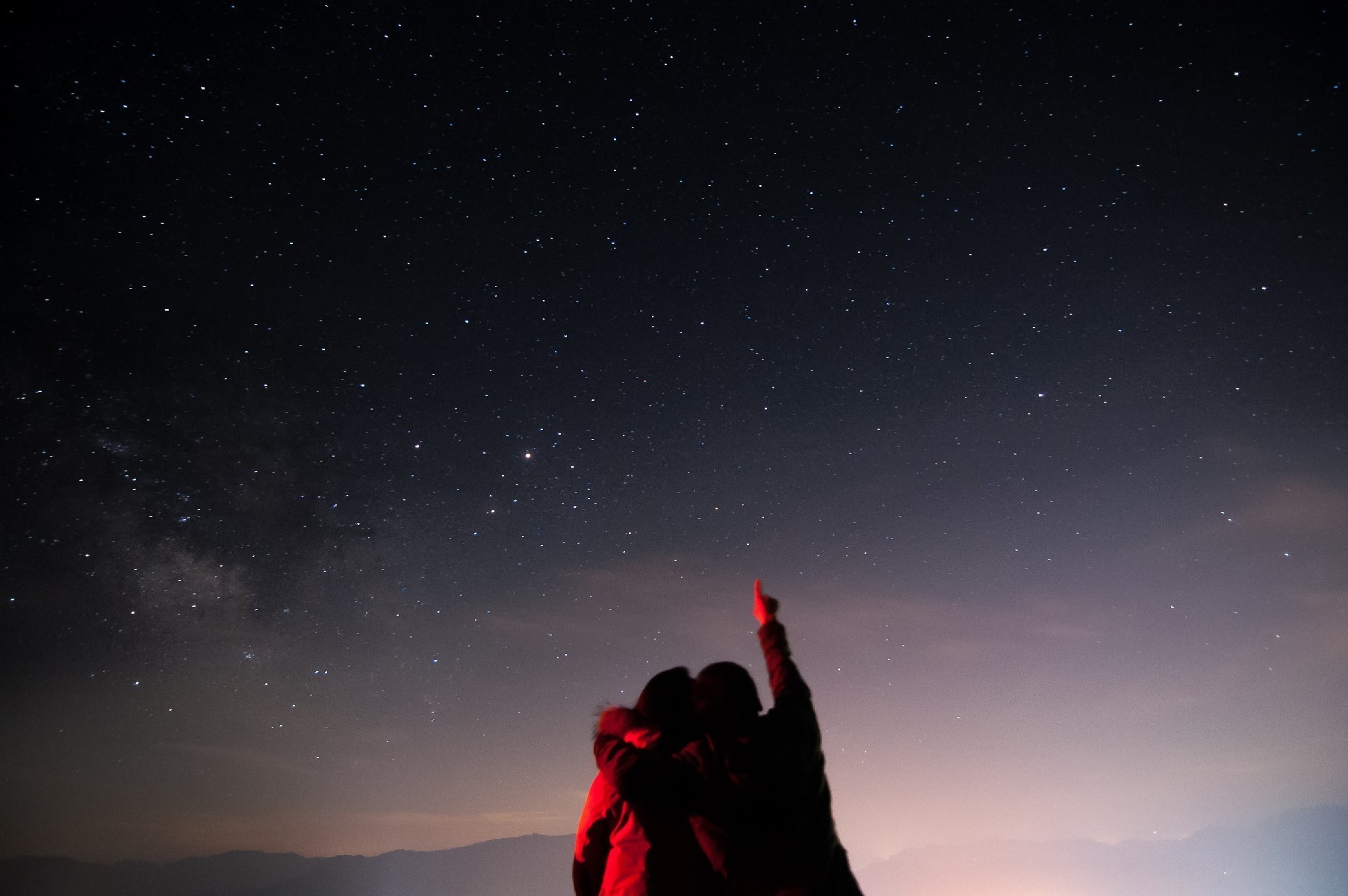
Who can travel to space?
Anyone ! Well, that is, anyone with enough money. No need to have any previous science qualifications or NASA training, especially since a trained crew will escort tourists on their galactic journey.
According to Virgin Galactic, future space tourists will be between 10 and 90 years old, and come from diverse professional and cultural backgrounds.
The only thing you need? The desire to explore the universe!
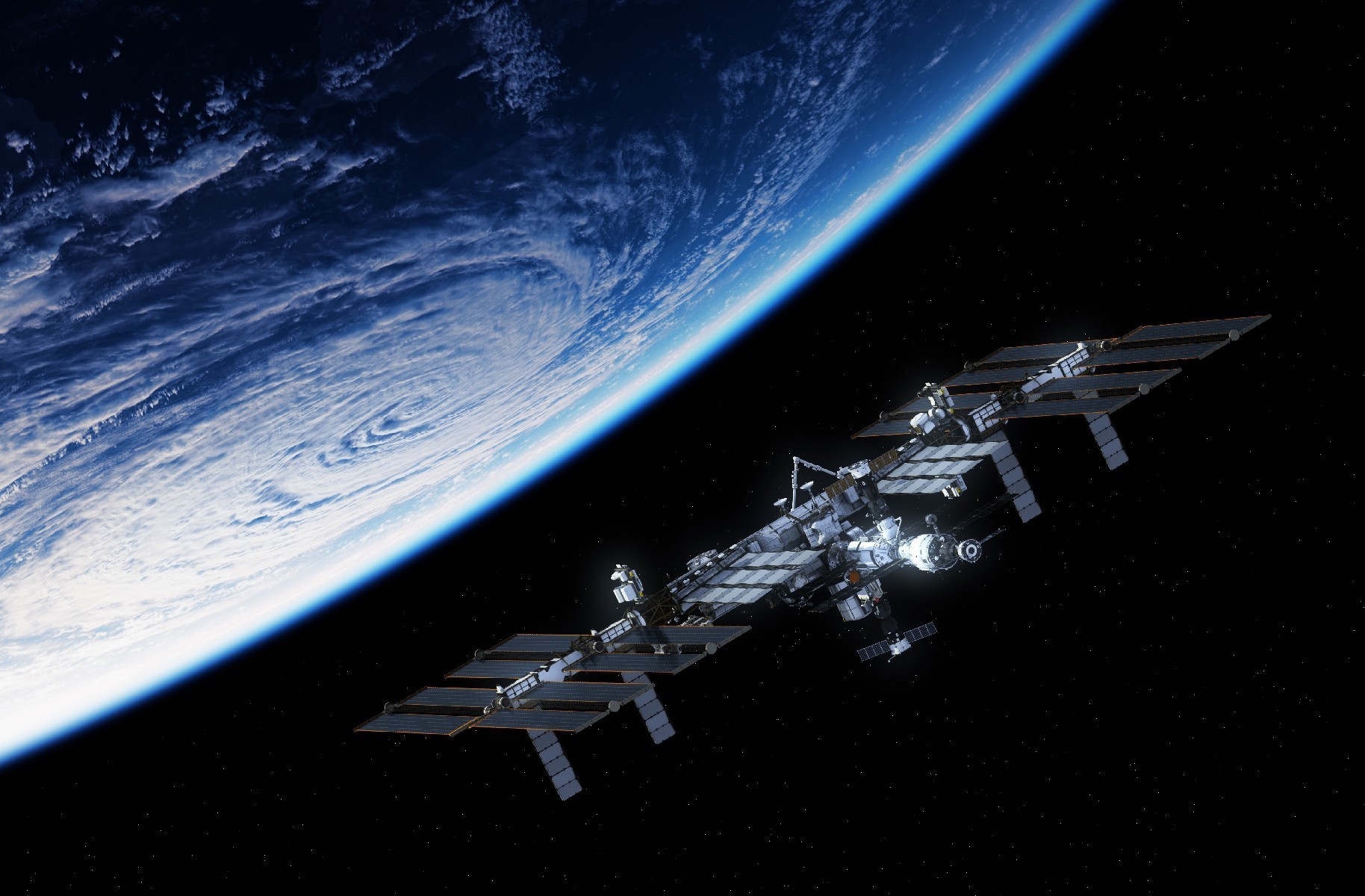
What is orbital travel?
The main difference between orbital and suborbital flights lies in the trajectory and speed of the vessels.
To go into orbit, a rocket or spaceship needs to follow a path that goes around the Earth at the very fast minimum speed of 7.7 kilometres (4.8 miles) per second, in order to keep circling and never fall back down.
It allows astronauts and travellers to stay in space for extended periods of time, hence it is for now the preferred type of flight.
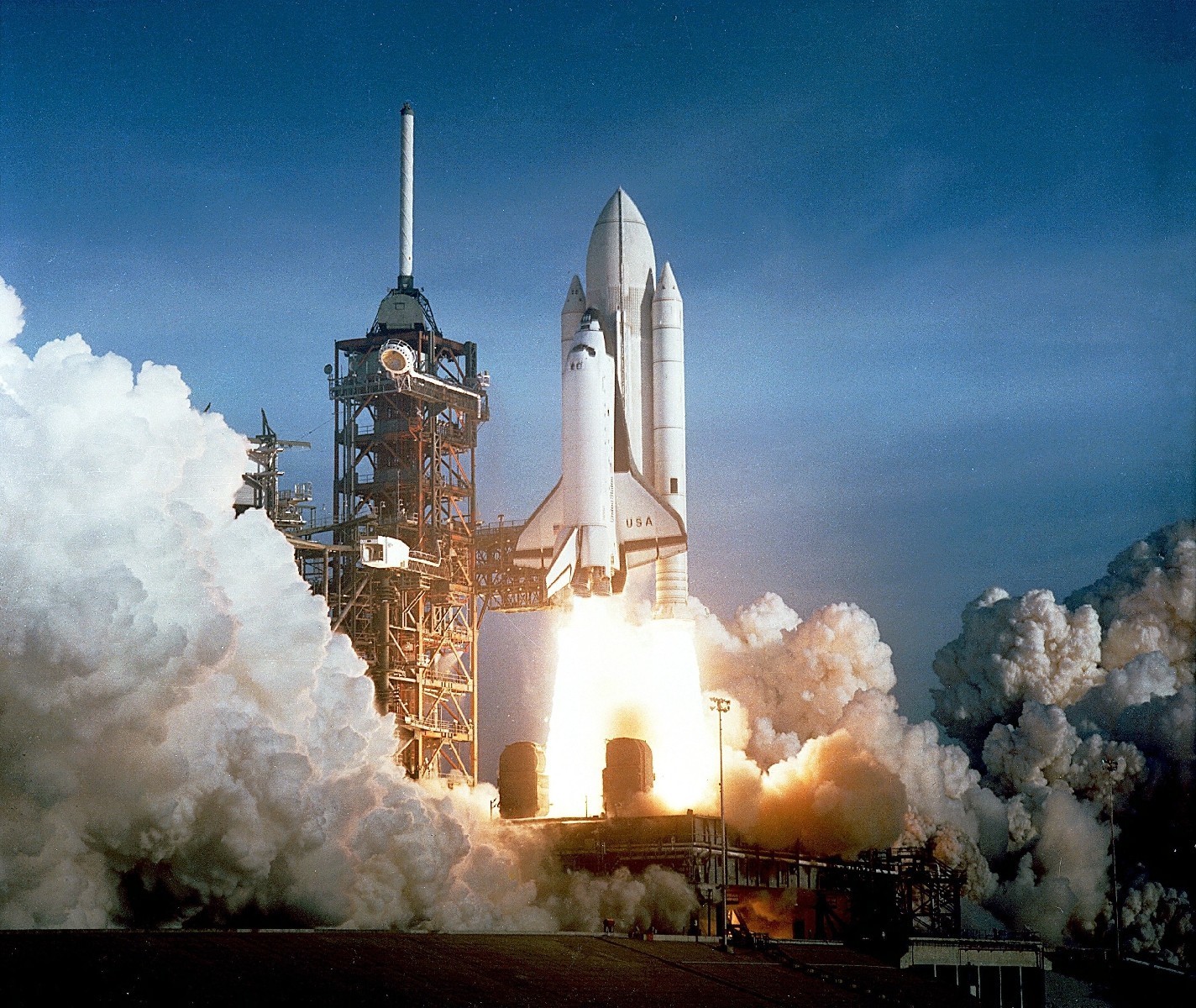
What is suborbital travel?
A suborbital flight , which is what Branson and Bezos did, “just” requires enough energy to blast off to space and then naturally fall back to Earth, making a huge arc.
It requires less energy and is less costly than orbital flights, thus opening doors for relatively affordable space tourism in the future.
Passengers would experience up to six minutes of weightlessness and a grandiose view.

How do you prepare?
Although Virgin Galactic doesn’t explicitly list its physical requirements, they did say astronauts would have to pass certain medical checkups and training programs. Blue Origin, on the other hand, has said that training for suborbital trips will only take a day.
And of course, any space tourist will also have to pass a series of thorough tests to determine whether they’re fit to fly up there.
Once in space, you may have to perform small bouts of exercise to prevent muscle wasting , which takes place after just seven days.

What is lunar tourism?
As its name hints, lunar tourism is the project of sending paying travellers to the moon. The first one could happen as soon as 2023, and would consist of a loop flight.
But three types of lunar tourism could be available in the near future: circumlunar trajectory, lunar orbit, and even lunar landing.
How cool would it be to say to someone, upon returning from a lunar vacation, “I’ve literally loved you to the moon and back”?

Where does space tourism take place?
Admittedly, space is a vast place. So where exactly would tourists go ?
First, any space travel begins with the Kármán line , which lies at 100 kilometres (62 miles) above sea level and is commonly accepted as the limit between Earth’s atmosphere and outer space.
Then, there are several options: orbital, suborbital, and lunar space tourism.
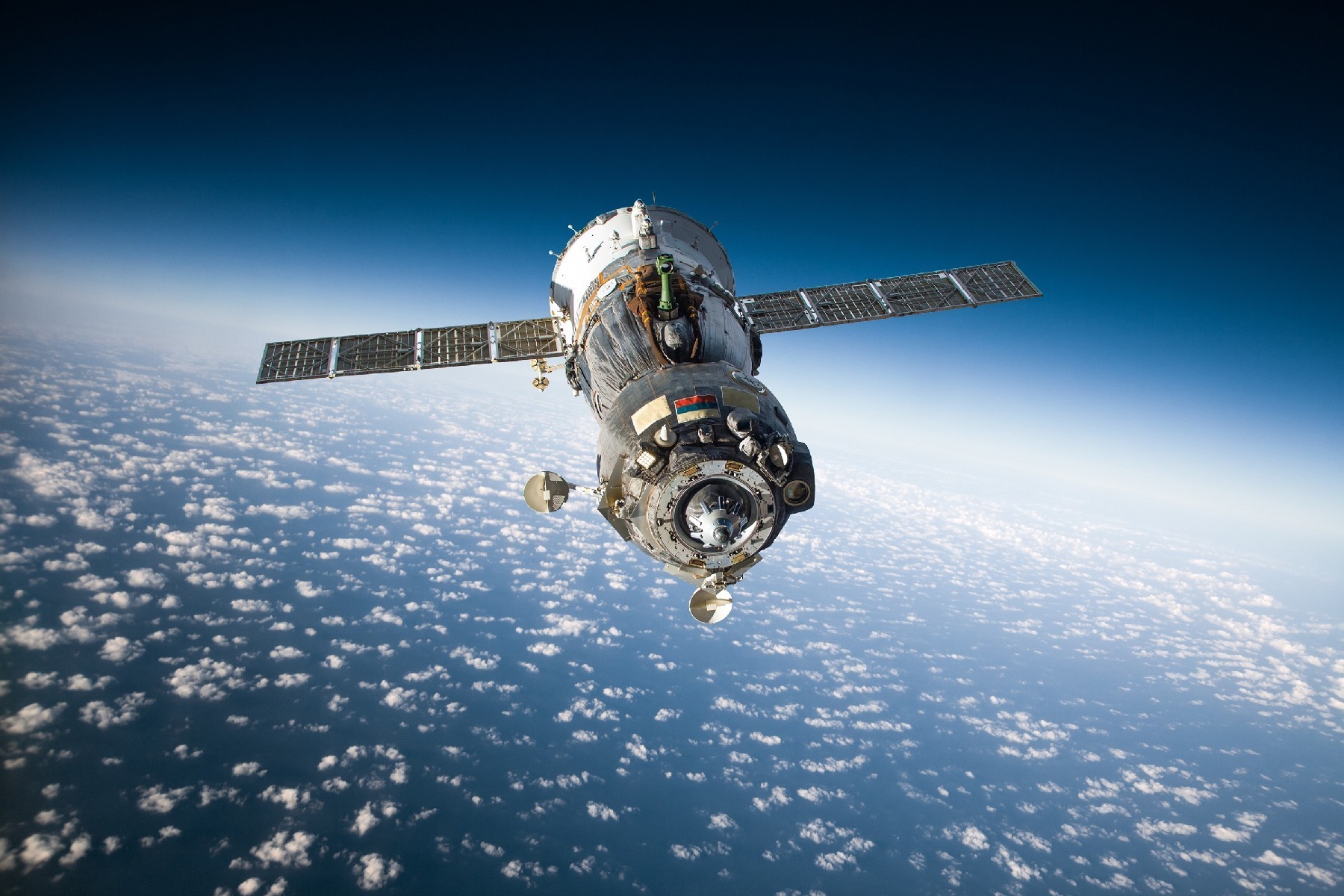
Have touristic space travels already occurred?
Yes! From 2001 to 2009, the Russian space agency and the U.S.-based space tourism company Space Adventures took seven (very wealthy) members of the public for several orbital space travels to the International Space Station.
The flights took place aboard the famous spacecraft Soyuz but stopped in 2010, since the crew of actual astronauts grew bigger and left no more seats available for paying space tourists.
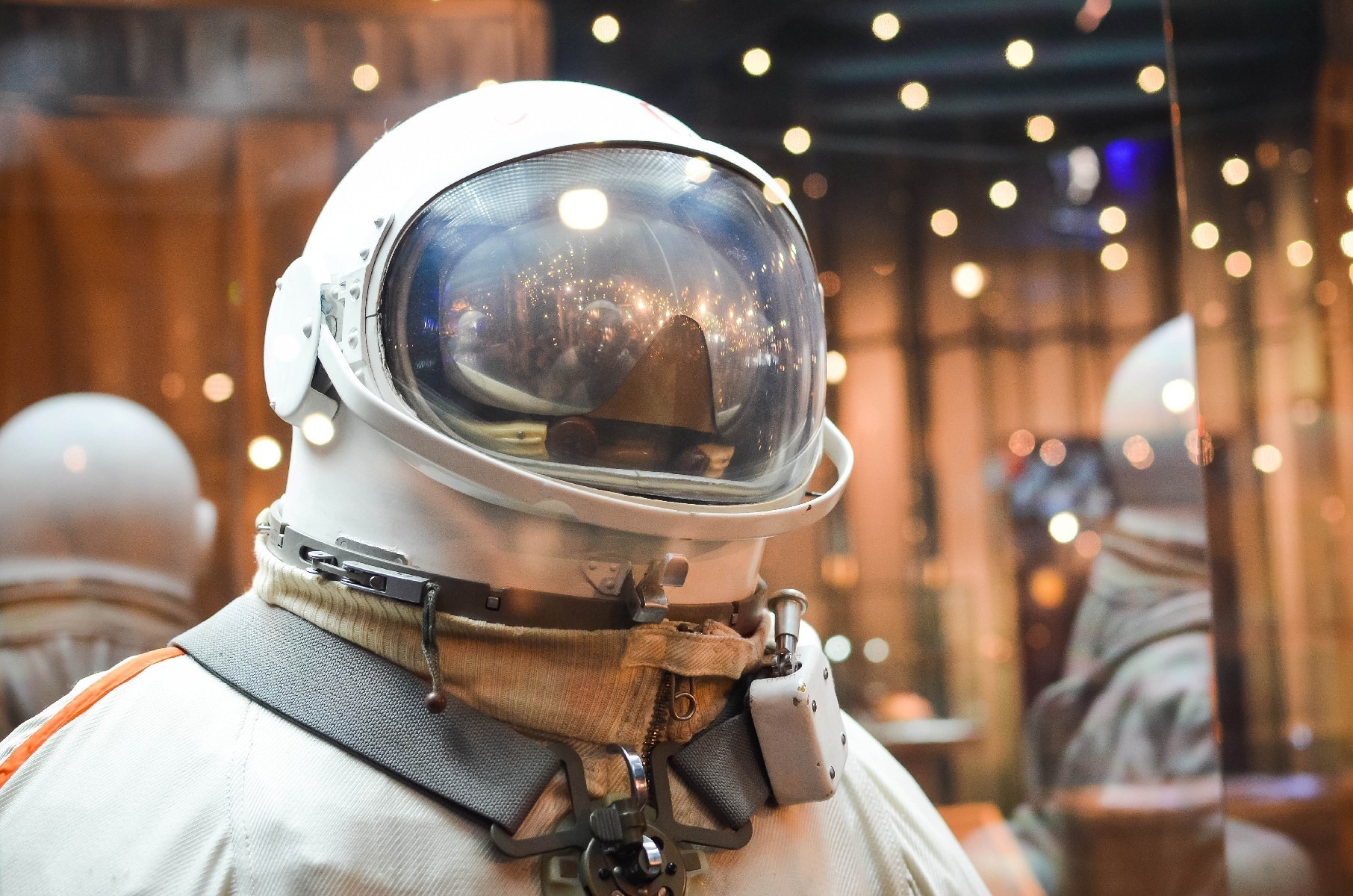
Who were the first space tourists?
The American businessman Dennis Tito became officially the first space tourist in April 2001, when he stayed for seven days on the International Space Station.
He was followed by six multimillionaire fellows from various countries: South African entrepreneur Mark Shuttleworth, American scientist Gregory Olsen, Iranian engineer Anousheh Ansari (the first female space tourist), Hungarian-American computer programmer Charles Simonyi, British video game mogul Richard Garriott, and Canadian businessman Guy Laliberté.
On July 11, 2021, billionaire Richard Branson, along with three Virgin Galactic employees and two pilots, reached an altitude of 85 kilometres (53 miles) above Earth aboard his Virgin Galactic rocket plane, the Unity. Less than 10 days later, on July 20, the world’s richest man, Amazon’s Jeff Bezos, briefly entered space on Blue Origin , his private space company’s reusable rocket. He was joined by his younger brother Mark, Dutch teenager Oliver Daemen, and Wally Funk, who, at 82 years old, became the oldest astronaut.
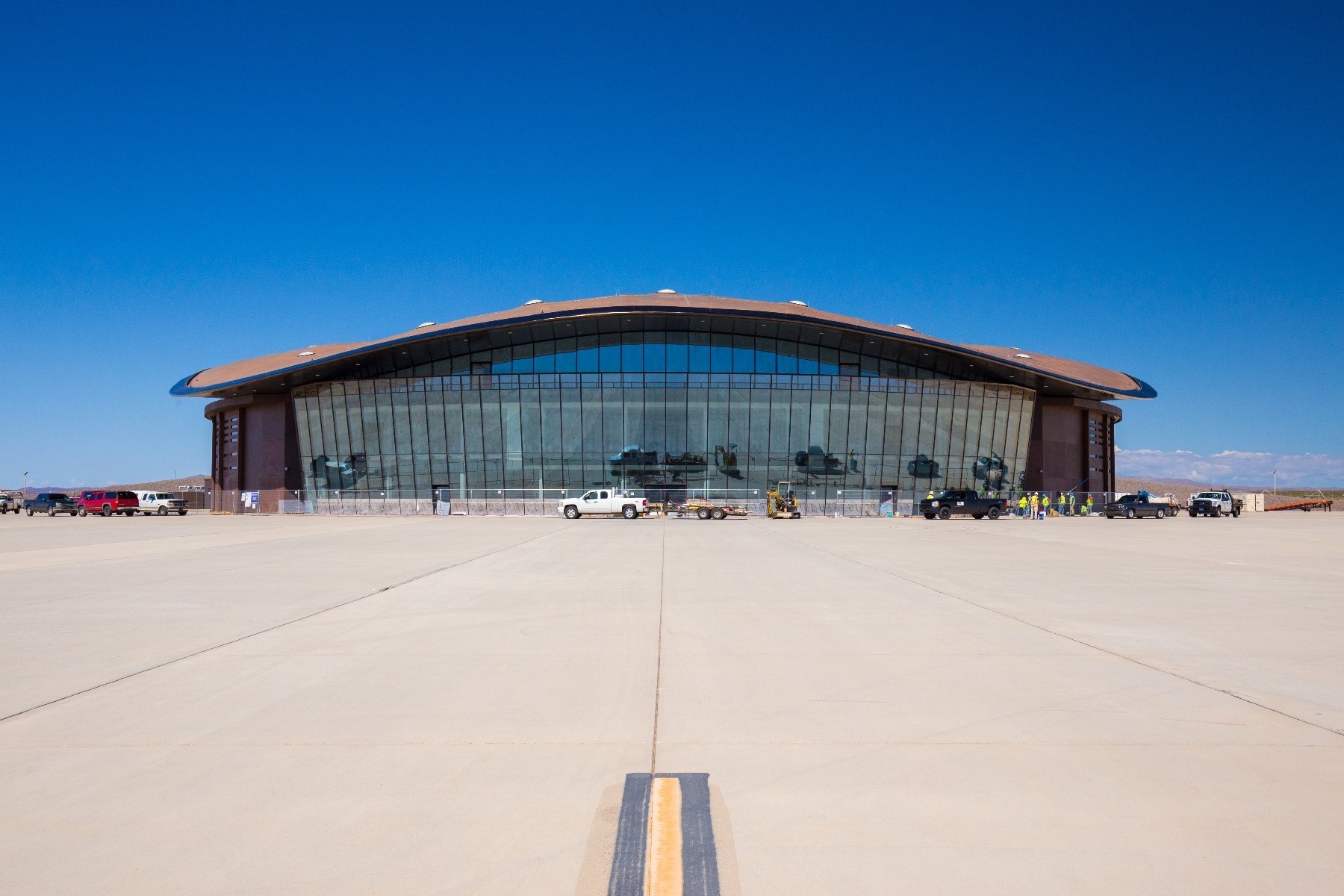
Who would be the space tourism “agencies”?
Unlike past tourism experiments, which took place aboard vessels sent off for scientific purposes, future travels will happen on private companies’ flights set up solely for space tourism.
Those pioneering aerospace companies are Richard Branson’s Virgin Galactic ; SpaceX, founded by Tesla co-founder Elon Musk ; and Blue Origin , created by Amazon founder Jeff Bezos.
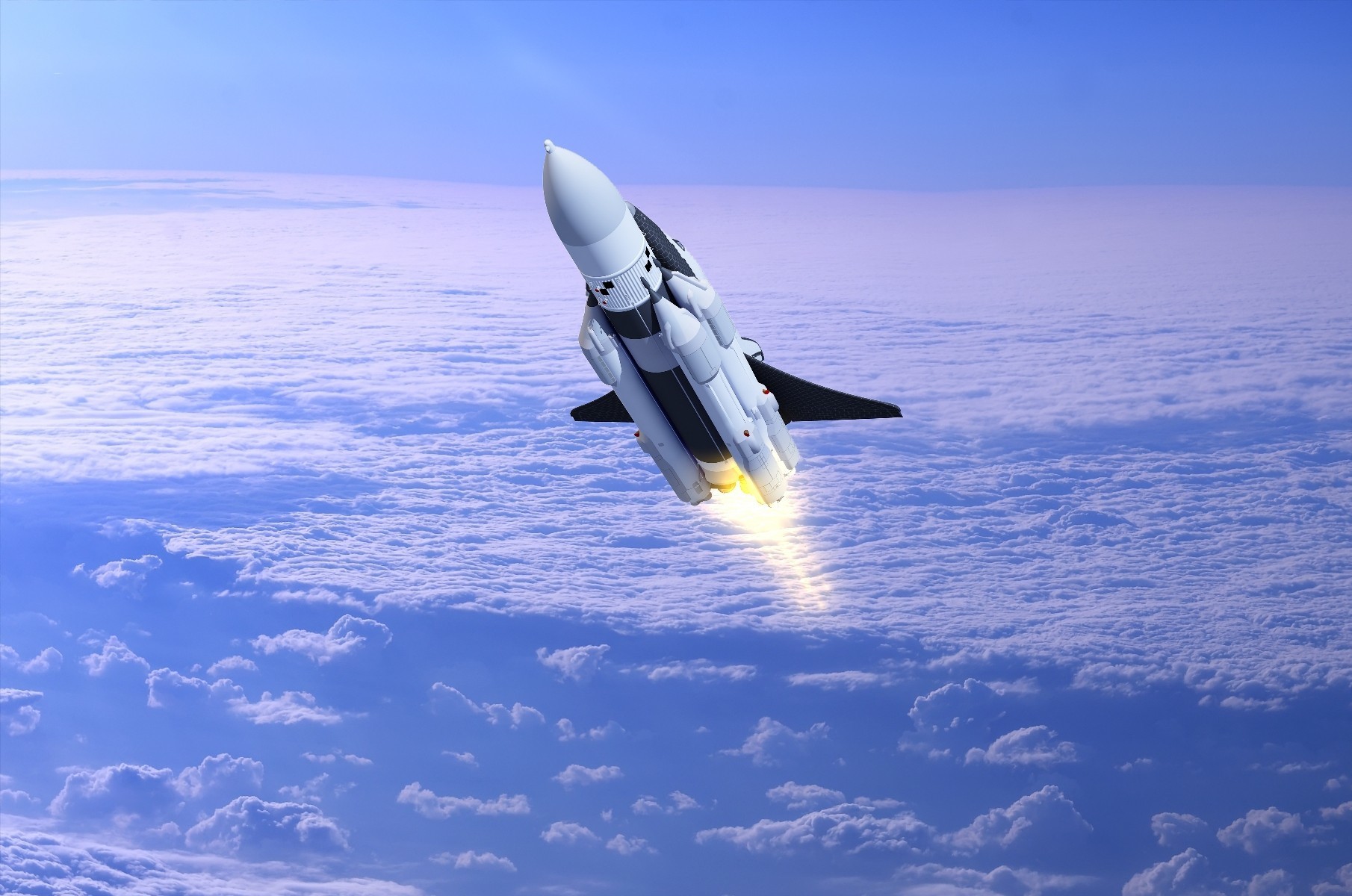
When will space tourism happen?
Sooner than you think. According to Forbes , Virgin Galactic’s successful trip means the company could start sending civilians up into space as soon as early 2022. Likewise, Blue Origin, which has a Federal Aviation Administration licence for human space travel through August 2021, could officially enter the space tourism game by early 2022.

How much will it cost?
It’s not exactly clear at the moment, but there have been some indications. For example, Virgin Galactic began selling ticket reservations for US$250,000 and sold roughly 600, before a test crash in 2014 brought sales to a halt. They’re expected to start selling tickets again in 2022, but at a much higher price.
It was reported in 2018 that seats on Bezos’s Blue Origin would also cost in the ballpark of US$200,000 to US$300,000, but that could change given how high demand is. At a recent auction, the winning bid for a seat aboard the company’s first spaceflight was a whopping US$28 million .
The bottom line is, those hoping to take a trip around the stars will either need to know someone or have hundreds of thousands (likely even millions) of dollars to spare.
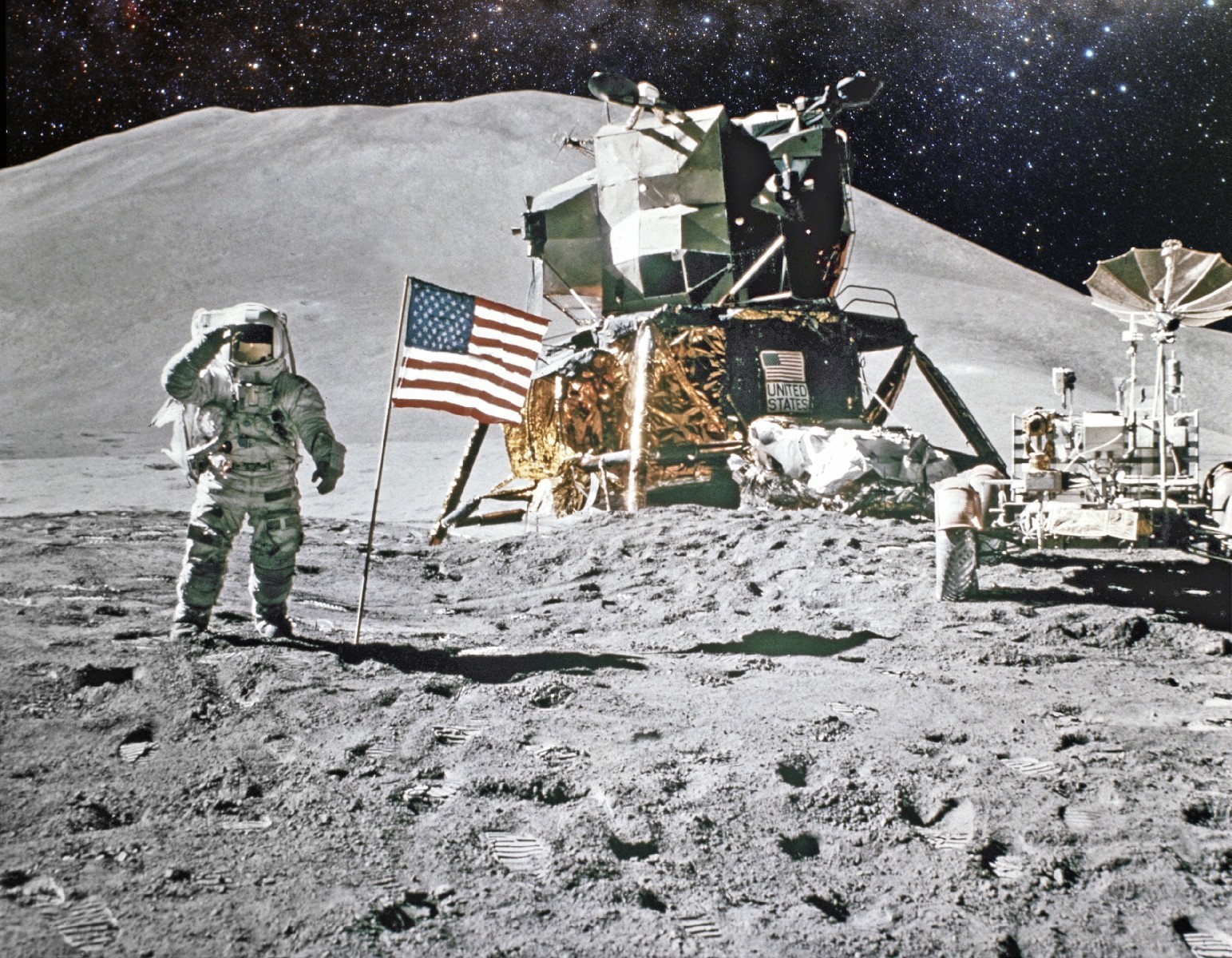
How do we get there?
The development of space tourism vehicles is still an ongoing project.
But a few options already exist, like Virgin Galactic’s spaceplanes that can carry up to eight people, or SpaceX’s Dragon spacecraft , launched by the Falcon Heavy rocket.
Blue Origin’s New Shepard looks more like a regular rocket that takes off and lands vertically, but also claims to offer the biggest windows of any spacecraft—a good selling point. It comfortably sits six people and is fully autonomous, meaning no pilot onboard.
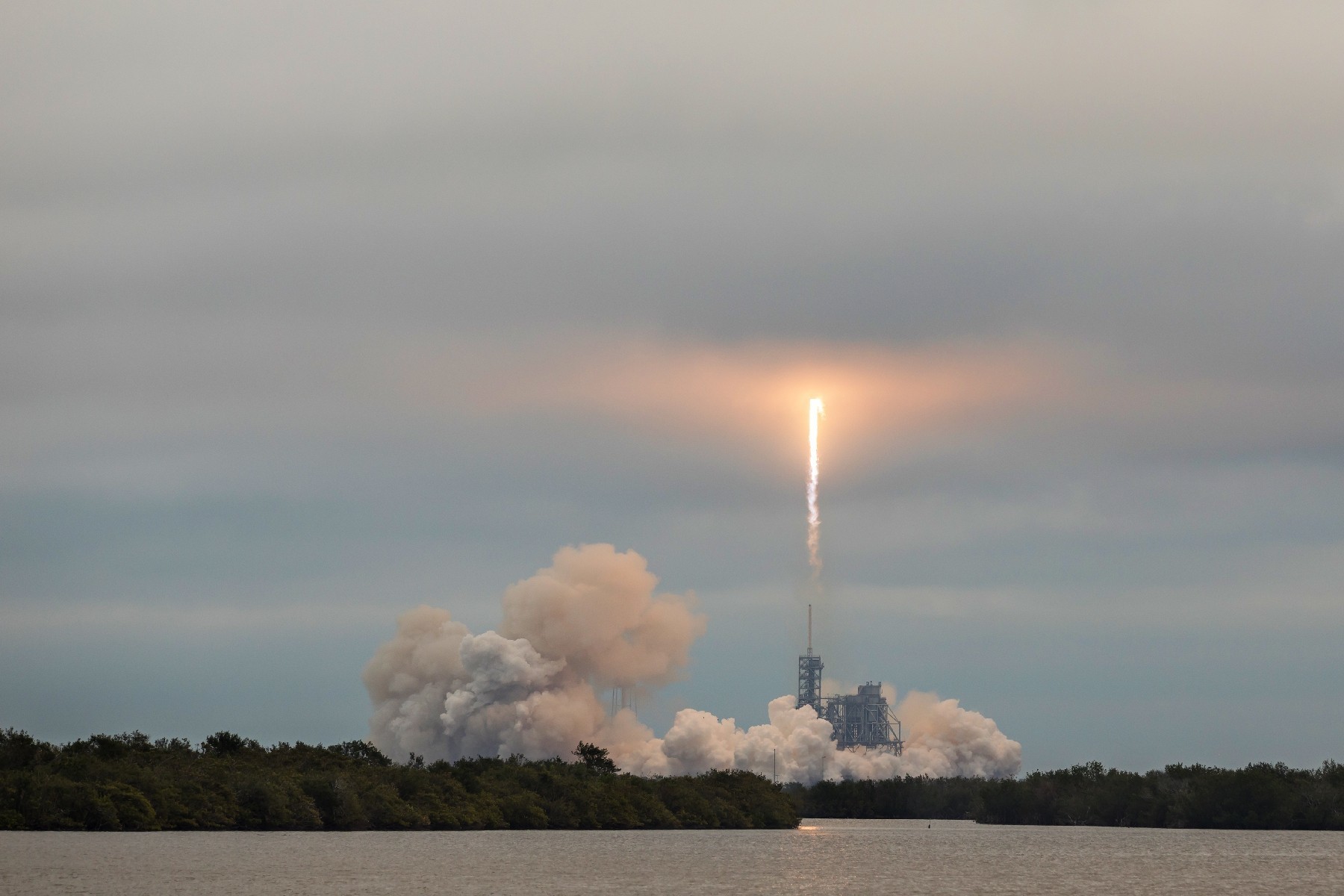
What does it feel like?
Needless to say, travelling to space is no walk in the park.
You’re eager to experience the joys of floating in microgravity? You better also get prepared to endure several physical discomforts: nausea and sea sickness, dizziness, headache, disorientation, puffy face, and bloodshot eyes.
But astronauts and previous space tourists agree that the body adjusts fairly quickly, getting used to its spatial environment in about three days.

Is it safe?
Safety is a reasonable concern , considering the many hazards involved in space travel: the probability of a crash, exposure to cosmic radiation, and even unknown dangers that could emerge with this new industry. But here is the real question for any adventurer: is the thrill worth the risk?

What is the food like?
For many tourists, food is a crucial criterion for a successful vacation. But outer space is no place for gourmets, at least not yet. Interstellar tourists can expect to enjoy mostly canned, modified, and pre-packaged meals (such as space burritos and freeze-dried ice cream). But soon, thanks to NASA’s veggie farm , space tourists might be able to savour space-grown salads.
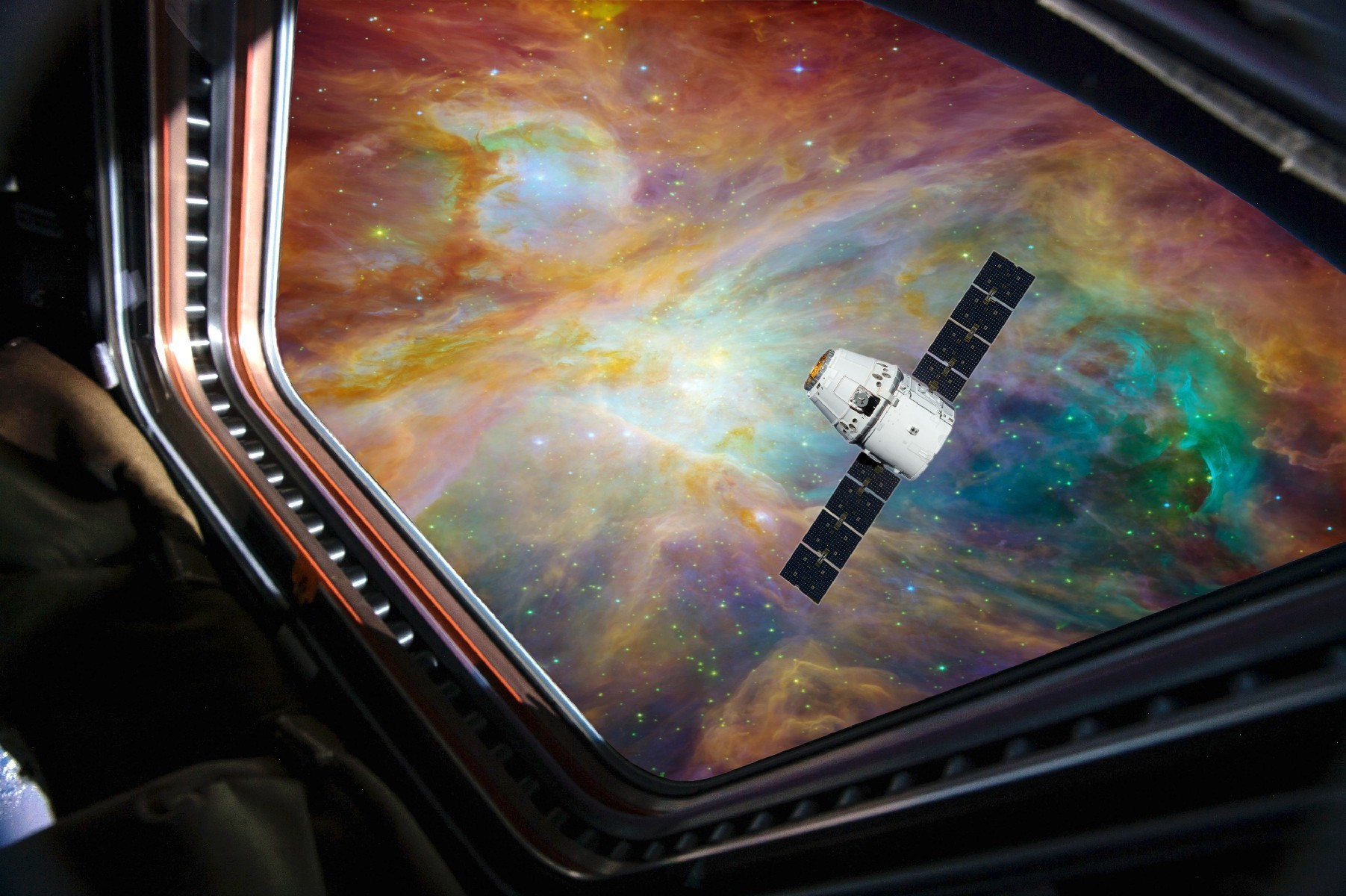
What about the accommodations?
Orbital space travel allows you to stay up there for a few days or even weeks. At that point, you might want to stretch your legs outside of the spacecraft, right? Well, in the future, space stations could be used as hotels: the Genesis inflatable habitats by Bigelow Aerospace and the Space Island Project are existing examples. Make sure to book a room with a view of planet Earth!
How to pack a space suitcase?
Packing a suitcase for a trip through the cosmos is actually less of a headache than doing so for a weekend vacation on Earth. Just keep in mind that it’s impossible to do laundry in space, so pack clothes accordingly : stock up on underwear, light clothing (space station temperature is controlled at about 22 degrees Celsius, or 72 degrees Fahrenheit), and exercise outfits. Outerwear will be provided: an orange suit for takeoff and re-entry, and a white one for potential space strolls.
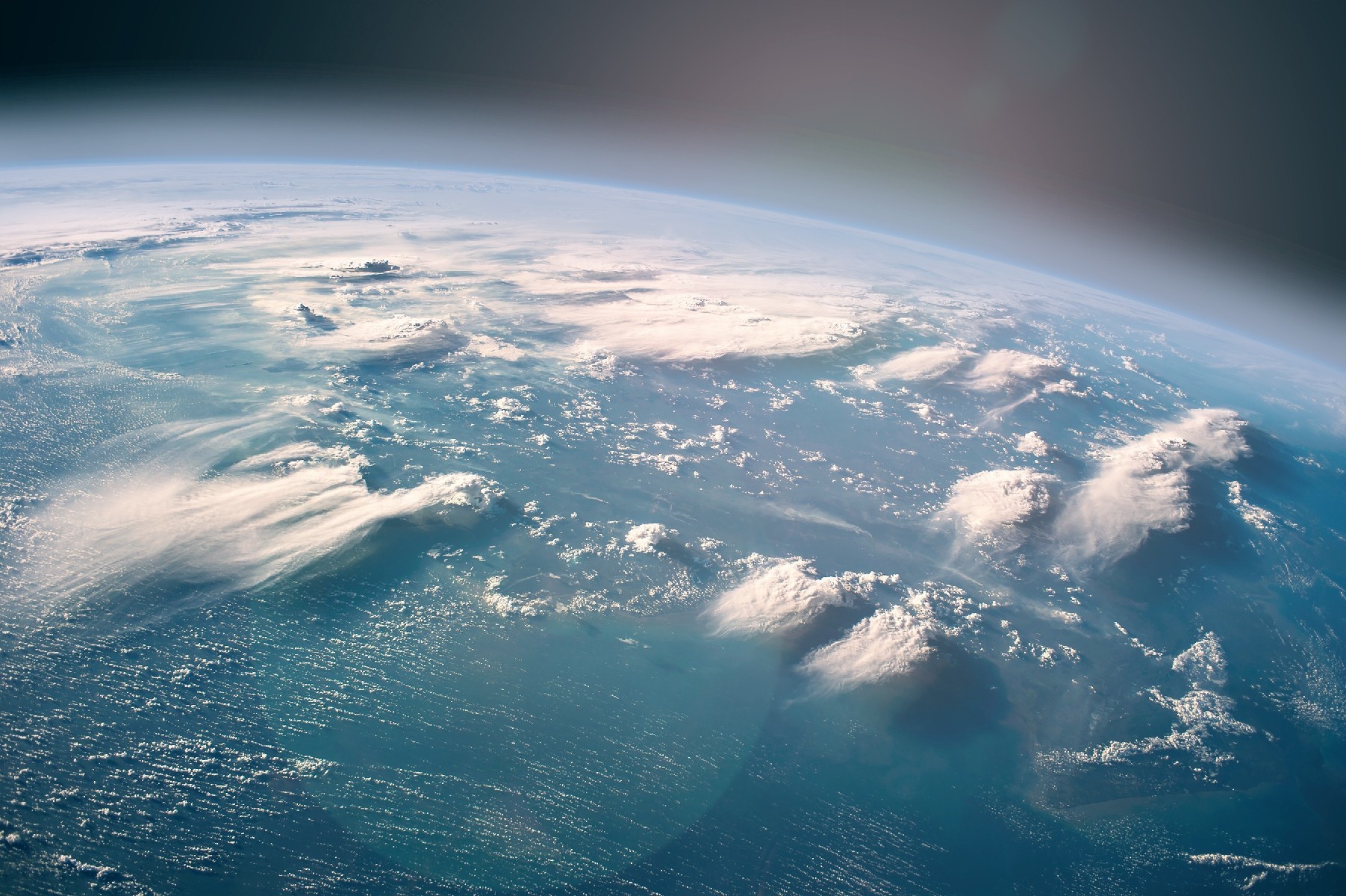
Is it eco-friendly?
With ecotourism being a growing trend and concern over the last few years, the question is legitimate. Well, bad news: space travel could have a negative impact by accelerating global warming . This would be caused by the black carbon released into the stratosphere after suborbital launches. But of course, entrepreneurs in the industry claim that the carbon footprint of space tourism would be minimal. The truth is, rockets emit 50 to 100 times more CO₂ per passenger than a regular flight. Considering that Virgin Galactic plans to do 400 trips per year, that’s a lot of CO₂ entering the atmosphere.
More for You
Ex-WNBA player Val Whiting makes clear stance on transgender athletes in women's sports
Common over-the-counter medicine linked to increased dementia risk
Teen ends up with stoma after period pain worry
Stephen Colbert is mourning the death of his assistant – how do you properly grieve a colleague?
10 Aldi Items Frugal People Always Buy
Watch: What Happened With Cody Rhodes After WrestleMania Saturday (4/3) Went Off Air
Greta Thunberg Dragged Away From Climate Protest in The Hague
What to do when your own number appears to ring your home phone
The health condition many women are getting diagnosed with after COVID
It was a popular national monument, until it was robbed to extinction
Toy Company Launches Life-Sized M3GAN Doll Replica
Popular discount retailer shuts down all stores, liquidating
19 Easy Ways to Fall Back Asleep After Waking Up in the Middle of the Night
Pink Mold in Your Shower? What It Is and How to Get Rid of It
5 Netflix movies to watch when the kids have gone to bed
A drink now may impact you more than it would years ago. Here’s why that’s a problem
Belgian breakthrough: Stool transplant shows promise for improving symptoms of Parkinson's disease
Ukraine appeared to strike a Russian tank equipped with a makeshift electronic warfare system — but that may worry Ukraine
8 Places You Should Never Charge Your Phone
Doctor shares what happens to our bodies moments before we die
A Vacuum Full of Infinite Energy

By Harnessing the Unlimited Vacuum Energy In Space, We Could Finally Reach Light Speed
Invisible vacuum energy is all around us. We could use it to power propulsion, enhance nanostructures, and build levitating devices.
Gear-obsessed editors choose every product we review. We may earn commission if you buy from a link. Why Trust Us?
This landmark experiment, first devised by Casimir just after World War II—and only realized 25 years ago—paved the way for scientists to witness the manifestations of quantum theory in a real, practical way. Quantum fields and their vibrations power our modern-day understanding of physics, from subatomic interactions to the evolution of the entire universe. And what we learned, thanks to Casimir’s work, is that infinite energy permeates the vacuum of space. There are many ideas in the science fiction universe that propose using vacuum energy to power a starship or other advanced kind of propulsion, like a warp drive. While these ideas are still dreams, the fact remains that a simple experiment, devised in 1948, set fire to our imaginations and our understanding of the universe.
Casimir , a Dutch physicist, had spent his graduate years with his advisor, Niels Bohr, one of the godfathers of quantum physics , and had picked up a liking for this new, extraordinary theory of the cosmos. But as quantum theory evolved, it started to make extremely strange statements about the universe . The quantum world is weird , and its ultimate weirdness is normally invisible to us, operating at scales well below our normal human perception or experimentation. Casimir started to wonder how we might be able to test those ideas.
He went on to discover a clever way to measure the effects of ever-present infinite quantum fields merely using bits of metal held extremely close together. His work showed that quantum behavior can manifest in surprising ways that we can measure. It also showed that the strangeness of quantum behavior is real and can’t be ignored, and what quantum mechanics says about the workings of the universe —no matter how bizarre—must be believed.
Quantum Fields Are Otherworldly, But Very Real
One of the lessons of the quantum world is that particles , like electrons, photons, neutrinos, and whatnot, aren’t what they seem to be. Instead, each of the particles that we see in nature is actually just a piece of a much larger, grander entity. These grander entities are known as quantum fields, and the fields soak every bit of space and time—all throughout the universe—the same way that oil and vinegar soaks a piece of bread.

There is a quantum field for every kind of particle: one field for the electrons , one for the photons, and so on. These fields are invisible to us, but they make up the fundamental building blocks of existence. They are constantly vibrating and buzzing. When the fields vibrate with enough energy, particles appear. When the fields die down, the particles disappear. Another way to look at this is to say that what we call a “particle” is really a localized vibration of a quantum field. When two particles interact, it’s really just two pieces of quantum fields interacting with each other.
.css-2l0eat{font-family:UnitedSans,UnitedSans-roboto,UnitedSans-local,Helvetica,Arial,Sans-serif;font-size:1.625rem;line-height:1.2;margin:0rem;padding:0.9rem 1rem 1rem;}@media(max-width: 48rem){.css-2l0eat{font-size:1.75rem;line-height:1;}}@media(min-width: 48rem){.css-2l0eat{font-size:1.875rem;line-height:1;}}@media(min-width: 64rem){.css-2l0eat{font-size:2.25rem;line-height:1;}}.css-2l0eat b,.css-2l0eat strong{font-family:inherit;font-weight:bold;}.css-2l0eat em,.css-2l0eat i{font-style:italic;font-family:inherit;} There’s no such thing as a true vacuum; wherever you go, there are always vibrating quantum fields.
These quantum fields are always vibrating, even when those vibrations aren’t strong enough to produce a particle. If you take a box and empty out all of the stuff—all the electrons, all the photons, all the neutrinos, all the everything—the box is still filled with these quantum fields. Since those fields vibrate even in isolation, that means the box is filled with invisible vacuum energy, also known as zero-point energy—the energy of these fundamental vibrations.
In fact, you can calculate how many vibrations are in each of these quantum fields ... and the answer is infinity! There are small ones, medium ones, big ones, and gigantic ones, all flopping on top of each other continuously, as if spacetime itself was boiling at the subatomic level. This means that the vacuum of the universe really is made of something. There’s no such thing as a true vacuum; wherever you go, there are always vibrating quantum fields.
A Simple Experiment Involves Multiple Infinities
This is where Casimir’s experiment comes in: If you take two metal plates and stick them really, really close together, the quantum fields between those plates must behave in a certain way: the wavelengths of their vibrations must fit perfectly between the plates, just like the vibrations on a guitar string have to fit their wavelengths to the length of the string. In the quantum case, there are still an infinite number of vibrations between the plates, but—and this is crucial—there are not as many infinite vibrations between the plates as there are outside the plates.
How does this make sense? In mathematics, not all infinities are the same, and we’ve developed clever tools to be able to compare them. For example, consider one kind of infinity where you add successive numbers to each other. You start with 1, then add 2, then add 3, then add 4, and so on. If you keep that addition going forever, you’ll reach infinity. Now consider another kind of addition, this one involving powers of 10. You start with 101, then add to it 102, then 103, then 104, and keep going.
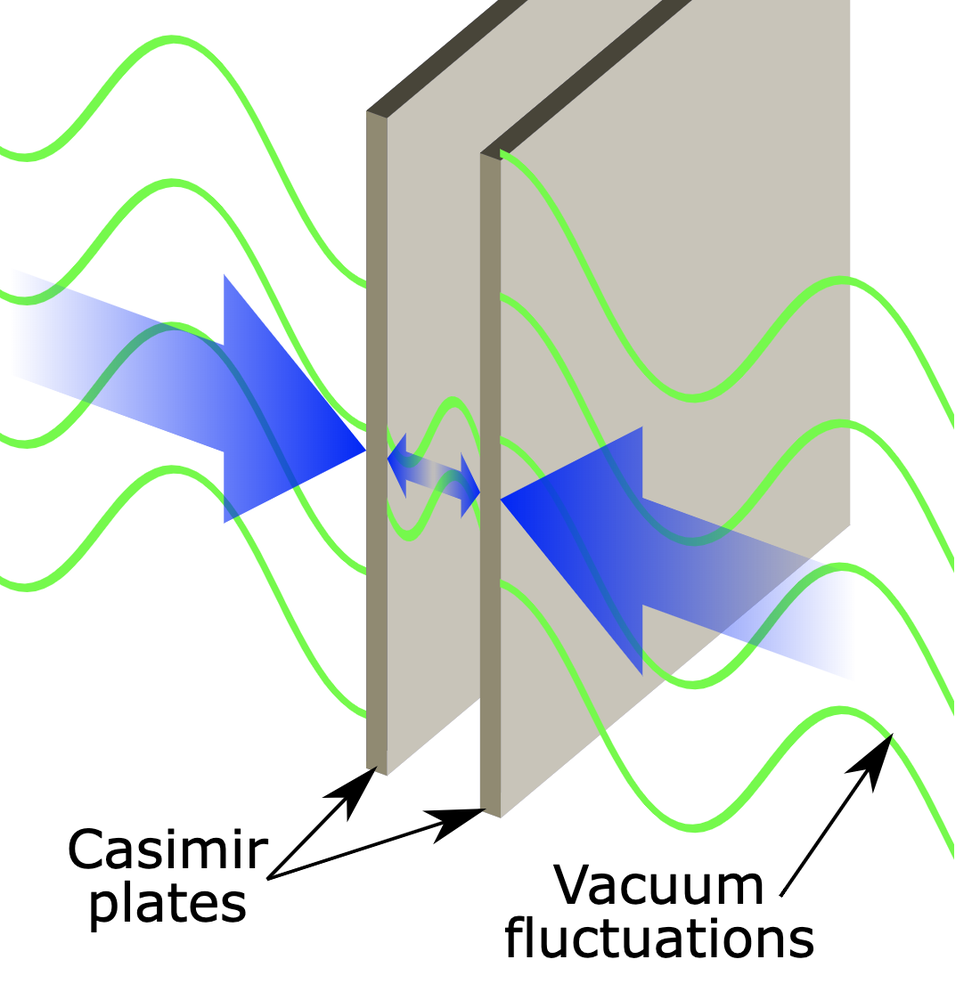
Again, if you keep this series going on forever, you’ll also reach infinity. But in a sense you’ll “get” to infinity faster. So by carefully subtracting these two sequences, you can get a measure of their difference even though they both go to infinity.
Using this clever bit of mathematics, we can subtract the two kinds of infinities—the ones between the metal plates and the ones outside—and arrive at a finite number. This means that there really are more quantum vibrations outside the two plates than there are inside the plates. This phenomenon leads to the conclusion that the quantum fields outside the plates push the two plates together, something called the Casimir effect in Hendrik’s honor.
The effect is incredibly small, roughly 10 -12 Newtons, and it requires the metal plates to be within a micrometer of each other. (One Newton is the force which accelerates an object of 1 kilogram by 1 meter per second squared.) So, even though Casimir could predict the existence of this quantum effect, it wasn’t until 1997 that we were finally able to measure it, thanks to the efforts of Yale physicist Steve Lamoreaux.
🦎 Quantum Physics In Action Perhaps most strangely, the creature with the deepest connection to the fundamental quantum nature of the universe is the gecko. Geckos have the ability to walk on walls, and even upside-down on ceilings. To accomplish this feat, a gecko’s limbs are covered in countless, microscopic hair-like fibers. These fibers get close enough to the molecules of the surface it wants to climb on for the Casimir effect to take action. It creates an attractive force between the hair and the surface. Each individual hair provides only an extremely tiny amount of force, but all the hairs combined are enough to support the gecko.
In this experimental setup, which can fit on a kitchen countertop, the plates don’t magically pull themselves together. Instead it’s the infinite vibrating quantum fields of spacetime pushing them together from the outside.
We don’t normally see or sense or experience the Casimir effect. But when we want to design micro- and nano-scale machines , we have to account for these additional forces. For example, researchers have designed micro-scale sensors that can monitor the flow of chemicals on a molecule-by-molecule basis, but the Casimir effect can disrupt the operations of this sensor if we didn’t know about it.
Scientists Are Exploring the Potential of Vacuum Energy
For several years, researchers have been investigating the possibility that we really can extract vacuum energy and use it for energy. A 2002 patent was awarded for a device that captures the electric charge from the Casimir experimental setup’s two metal plates, charging a storage battery. The device can be used as a generator. “To continuously generate power a plurality of metal plates are fixed around a core and rotated like a gyrocompass,” according to the patent.
💫 Scientists Believe Light Speed Travel Is Possible. Here’s How.
The U.S. Defense Department’s Defense Advanced Research Projects Agency (DARPA) gave researchers $10 million in 2009 to pursue a better understanding of the Casimir force. Though progress in actually using vacuum energy continues to be incremental, this line of energy research could give rise to innovations in nanotechnology, such as building a device capable of levitation, researchers said at the time.
At the University of Colorado in Boulder, Garret Moddel ’s research group has developed devices that produce power “that appears to result from zero-point energy quantum fluctuations,” according to the group’s website . Their device essentially recreates Casimir’s experiment, generating an electrical current between the two metal layers that researchers could measure, despite applying no electrical voltage.
As for Casimir himself, who was immersed in a quantum revolution unfolding at Leiden University, he had a tendency to downplay the importance of his own work. In his autobiography, Haphazard Reality , Casimir said, “The story of my own life is of no particular interest.” And his monumental 1948 paper designing his experiment ends with the simple statement, “Although the effect is small, an experimental confirmation seems not infeasable and might be of a certain interest.”
In fact, his initial insight did not make a big splash on the scientific community, nor were there glowing popular press accounts of his experiment. Part of the reason was Casimir’s own modesty, and another is that he soon left academic research to pursue a career in industry. But despite these humble beginnings, his work cannot be understated.
Today, we continue to refine Casimir’s original experimental setup, searching for any cracks in our theories, and we use it as a foundation to explore ever more deeply the fundamental nature of the cosmos.
Paul M. Sutter is a science educator and a theoretical cosmologist at the Institute for Advanced Computational Science at Stony Brook University and the author of How to Die in Space: A Journey Through Dangerous Astrophysical Phenomena and Your Place in the Universe: Understanding Our Big, Messy Existence. Sutter is also the host of various science programs, and he’s on social media. Check out his Ask a Spaceman podcast and his YouTube page .

.css-cuqpxl:before{padding-right:0.3125rem;content:'//';display:inline;} Pop Mech Pro: Science .css-xtujxj:before{padding-left:0.3125rem;content:'//';display:inline;}

Could the Chair You Sit on Have a Soul?

Here’s How We Could Live in Trees

The Engine Driving Our Oceans Could Die by 2100

Can AI Help Solve Math’s Thorniest Mysteries?

You Can Give Your Body Back to Nature When You Die

How Does UFO Footage Play Tricks on Your Mind?

Why Doesn’t the Living Human Body ‘Go Bad’?

Is the Room-Temperature Superconductor Back?

What 9 Months on a Cruise Ship Can Do to You

Scientists Just Figured Out Why Pee is Yellow

5 Alien Hoaxes That Prove We Truly Want to Believe
What happens if it's cloudy for the April 8 solar eclipse?
Though everyone is hoping for clear skies, here's what might happen if an eclipse-chaser's worst enemy — clouds — decides to make an appearance.

If you cannot watch the eclipse in person or the weather is unfavorable, you can watch the total solar eclipse live here on Space.com . And keep up with all the actions with our total solar eclipse 2024 live updates blog.
It's now less than a week until the total solar eclipse on April 8 .
While many people will strive to be within the path of totality , where the moon's shadow completely blocks the sun's face. But even if you're within this path, it doesn't guarantee you'll have clear skies on eclipse day.
So what happens if it's cloudy where you are on April 8? Will you notice anything as the moon's shadow sweeps over you?
That depends on how thick and how extensive the clouds are. Regardless, you will certainly notice some very unusual effects when the moon's shadow passes by. I have had the misfortune of being completely clouded out of two of the 13 total solar eclipses I have journeyed to, and in a third case, I managed to sneak in a view of the corona even though virtually the entire sky was clouded over.
Related: How to give yourself the best chance of clear skies for April 8's solar eclipse
So, based on those three experiences, here is what you can expect to see if the weather does not work in your favor and you ultimately must utter those two words every eclipse chaser does not want to hear: "Clouded out!"
Passage of the moon's shadow

Available in a handy four-pack to kit out the whole family, these Celestron EclipSmart Solar Eclipse Glasses will keep you well protected while you view the eclipse. And don't miss our full guide to the best solar eclipse glasses and the best solar viewing kits to make the most of your experience.
Should there be considerable cloud cover on "E-Day," the clouds may actually have an advantage: They will provide a projection screen of sorts to view the rapid approach and departure of the moon's dark umbral shadow. Isabel Martin Lewis described the effect in her 1924 book "A Handbook of Solar Eclipses."
Get the Space.com Newsletter
Breaking space news, the latest updates on rocket launches, skywatching events and more!
"At the time of eclipse when the shadow of the moon sweeps over us we are brought into direct contact with a tangible presence from space beyond and we feel the immensity of forces over which we have no control," Lewis wrote. "The effect is awe-inspiring in the extreme. In fact, the passing of the moon's shadow, if one is fortunate to observe it, will be one of the most impressive features of the eclipse."
Mid-to-high-level clouds

If your sky is covered with mid-to-high-level clouds — cirrostratus, altostratus and/or cirrocumulus — you will likely be able to see the forward edge of the elliptical shadow move rapidly toward you and then over you just prior to and at the onset of totality. And with its passage may come a remarkable change in the overall quality of light on the surrounding landscape and a dramatic change in the clouds' color.
On July 10, 1972, at my very first total solar eclipse , my family and I were located just outside Cap-Chat, Quebec, a sleepy Canadian community of 2,000 whose population swelled to nearly 30,000 on eclipse day. The eclipse began under bright sunshine, mixed with some wispy high clouds. But as more and more of the sun became covered, the high cloudiness quickly increased and began to lower so that, at the onset of totality, virtually the whole sky was covered by a swath of battleship-gray clouds.
But upon the arrival of the moon's shadow, we saw its distinctly sharp edge move in. For those of a certain age who might remember the long-running television soap opera "The Edge of Night," whose opening showed an animation with a line of darkness sweeping over a city, that's exactly what I was reminded of as we were enveloped by the moon's umbral shadow. Once you actually experience it for yourself, it becomes easy to understand why this sight was so terrifying to ancient people.
Along with the sudden darkness came a change in the clouds' color. Behind the forward-moving edge of the moon's shadow were strange and exotic colors. The dull gray suddenly became yellow-orange and tints you'd see while looking through a beer or iodine bottle. Indeed, along the very edge of the disappearing sun at the start and end of totality, an arc of ruby red or fuchsia associated with the solar chromosphere appeared. It looked bright red because the hydrogen in the sun was emitting a reddish light at high temperatures, and some of this light may become evident in the clouds at the beginning and end of totality.
Some final comments regarding my 1972 eclipse experience. Despite the heavy cloud cover, we managed to catch sight of the totally eclipsed sun through a fortuitous opening in the overcast sky, some 30 seconds after totality began. As totality was ending, we saw the back edge of the shadow distinctly, projected on the clouds, racing away to the northeast. I remember my grandfather calling out to my grandmother, "Inez! Look, look! It's going that way." Meanwhile, my sister Lisa, taking this all in, said simply, "That was weird! "
"Incredible sight!"
Interestingly, in March 1970, during special coverage of the total solar eclipse on CBS TV , correspondent Bill Plante (1938-2022) was stationed in Halifax, Nova Scotia, under cloudy skies. Yet he was quite attentive to the changes taking place as the lunar shadow swept in.
"In the last 30 seconds we have witnessed the most incredible sight — in spite of the fact that we cannot see the sun — for it has become as dark as night!" he said. "The light has fallen so quickly, from an acceptable twilight or reading level or cloud-cover level, to virtual night. And just off to the north and to the east, beneath this layer of dark, dark sky, there is a lovely pink and orange horizon; an orange and gold color. We say again, it was just an incredible and fascinating phenomenon, to have the skies go so suddenly dark, in less than 30 seconds, and now we have this totality of an eclipse!"
It sounds like Plante was impressed, despite the clouds.
Just a few clouds
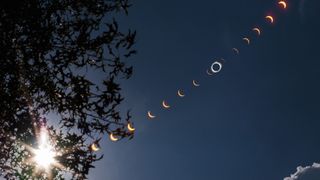
Sometimes, you're lucky enough to get a mainly clear sky. But even then, unfortunately, one of the few clouds in the sky might happen to be in front of the sun during the total phase of the eclipse.
That happened to me on Oct. 12, 1977, in Colombia, South America. During the 38-second interval of totality, a single rag of cloud drifted in front of the sun. Should something like that happen to you, the best you can do is look around the darkened sky for some of the brighter stars and planets and try to watch for the passage of the moon's shadow.
As I noted in my personal journal later on, "When totality arrived, virtually the entire sky was clear and the seeing and transparency were close to excellent. We were able to easily see seven stars and were awed at third contact by the passage of the moon's umbral shadow cone retreating rapidly to the east. And in the east, part of a rainbow changed to all red just as totality began.
"There was only one thing wrong: The sun was behind a cloud! It began encroaching upon the sun a few minutes before totality and left just a minute or two after the sun began to reappear. As if to rub salt into the wound, not another cloud interfered, even as the partially eclipsed sun set behind the Andes! For me, Colombia was Cap Chat in reverse. What goes around, comes around!"
For more on this misadventure, read my colleague Glenn Schneider's comments .
Thick, low clouds
Finally, there is the possibility that on eclipse day, your view will be covered by clouds at low altitudes, generally below 6,500 feet (1,980 meters). They tend to be thick, low, flat clouds that cover large areas and often bring precipitation.
In December 2021, my wife Renate and I were on board an icebreaker, sailing off the coast of Antarctica, when we encountered the moon's shadow for a total eclipse lasting just over a minute and a half. Unfortunately, our skies were heavily overcast with low clouds and spotty, light precipitation.
In such a situation, the effects of a total solar eclipse can best be described as being in a lighted room where someone turns a dimmer switch down and then turns it back up, causing the light to return.
As I noted in my story for Space.com , "Totality lasted 97 seconds. No distinct shadow or cone of darkness was noted. Rather, just an amorphous darkening of the sky — like someone turning down a rheostat or dimmer switch. No colors were seen and the end of totality seemed more pronounced as the light seemed to come back quicker than it when it faded away. During totality, it actually began to drizzle very lightly and a few minutes after third contact it actually started to snow lightly. The air temperature hovered at around 0°C (32°F), but factoring in the winds made it feel noticeably colder."

Final thoughts
I suppose Antarctica was the most disappointing of all my eclipse experiences; aside from getting dark and light again, there really wasn't much more to see. I hope everyone who positions themselves in the path of the moon's dark shadow will get a clear view of the April 8 eclipse. But as you can see, unless the clouds are low and thick with some rain or snow falling, the moon's shadow racing by and the eerie colors accompanying it should still make for quite a show!
Join our Space Forums to keep talking space on the latest missions, night sky and more! And if you have a news tip, correction or comment, let us know at: [email protected].

Joe Rao is Space.com's skywatching columnist, as well as a veteran meteorologist and eclipse chaser who also serves as an instructor and guest lecturer at New York's Hayden Planetarium. He writes about astronomy for Natural History magazine, the Farmers' Almanac and other publications. Joe is an 8-time Emmy-nominated meteorologist who served the Putnam Valley region of New York for over 21 years. You can find him on Twitter and YouTube tracking lunar and solar eclipses, meteor showers and more. To find out Joe's latest project, visit him on Twitter.
Coding the cosmos: Building an app for the total solar eclipse 2024 (op-ed)
My dogs and I watched the 2017 total solar eclipse, but we won't travel for this one
Maya nobility performed bloodletting sacrifices to strengthen a 'dying' sun god during solar eclipses
- FranRouse I was lucky enough to live downtown Charleston, S.C. in 2017 and witness the Total Solar Eclipse. It was a sight to see for sure and I hope to see this one. Only thing is now I live near Pittsburgh, Pa. and not in the direct path. And the weather is unpredictable this time of year with rain and still even snow possible. Ive seen a few eclipses in my lifetime and the one thing I want to stress is PLEASE WEAR EYE PROTECTION!!!!!!!!! When I was younger and seen my first one as kids we thought we were invincible and well being Gen X our parents weren't always around and a lot of us didn't have a clue about not looking directly into the sun. And some of us have really bad eyesight and as we get even older it's failing rapidly. I made that mistake back then so my eyes aren't good anymore. In 2017 I wore protection and made sure all my family wore it to witness the Eclipse. And all of them will wear it if we get the chance to see it this time also. Reply
- View All 1 Comment
Most Popular
By Daisy Dobrijevic April 06, 2024
By Space.com Staff April 06, 2024
By Joe Rao April 06, 2024
By Josh Dinner April 06, 2024
By Mike Wall April 06, 2024
By Monisha Ravisetti April 06, 2024
By Robert Lea April 06, 2024
By Elizabeth Howell April 06, 2024
By Meredith Garofalo April 05, 2024
By Robert Lea April 05, 2024
By Elizabeth Howell April 05, 2024
- 2 SpaceX launching 11-satellite Bandwagon rideshare mission tonight (April 7)
- 3 My dogs and I watched the 2017 total solar eclipse, but we won't travel for this one
- 4 White House directs NASA to create a new time zone for the moon
- 5 'Beacon 23' series returns to MGM+ on April 7 with glowing blue rocks and alien artifacts

IMAGES
VIDEO
COMMENTS
Welcome to Space. SPACE means "San Pedro de Atacama Celestial Explorations". It started in September in 2003, and has kept progressing. Our main activity is our star tours, which have already received more than 100000 participants in the last ten years. We now offer a complete solution for people who just want an introduction to the night sky ...
2022 Chile Astronomy & Stargazing. Join Sky & Telescope in Chile — the "astronomy capital of the world" — from October 12 to 23, 2022. Our group will visit world-class observatories, see breathtaking landscapes, and observe the southern sky in crystal-clear night skies. Seen here at sunset, the Very Large Telescope (VLT) is one of many ...
27 March 2025 - 13 days for £10,999 Experience the astronomical highlights of Chile, known as an astronomer's mecca. With 70% of the world's telescopes, Chile truly is the world ...
13 days from $9,990. Delve into the world of astronomy beneath the clear skies of northern Chile and enjoy exclusive access and behind-the-scenes tours of major observatories. This unique journey also balances culture, food, and wine alongside stargazing—from Santiago to the Atacama Desert. Request a Brochure. Make a Reservation.
Star Tours. Celestial discovery tours. SPACE (San Pedro de Atacama Celestial Explorations) has been operating in San Pedro since 2003. It was only about ten years later that other agencies in San Pedro started astronomical tourism, which is our only activity. Today there are more than fifty agencies in San Pedro that offer astronomical tours ...
The 45-mile gravel road that took me through the rock-strewn Atacama from Ruta 5 (Chile's main highway) to Cerro Paranal during my first visit there in 1998 has since been paved, providing much ...
Chile is an astronomer's dream. Here are some of its many dark-sky sites and observatories.
THE HIGHEST EXPERIENCE IN SOUTH AMERICA. The Sky Costanera Viewpoint is a unique space in Latin America, where you can enjoy the Andes Mountains and iconic places in Santiago de Chile from a completely new perspective. Come, climb to the top with us! Sky Costanera is open 7 days a week, 365 days a year. With our elevators, in less than a minute ...
You can't throw a space-rock without hitting a stargazing tour in San Pedro, but SPACE is the best around. Launched in 2003 by French astronomy Alain Maury and his Chilean wife Alejandra, an ...
Call 1.406.541.2677. Start Planning My Trip. Experience the astronomical highlights of Chile, known as an astronomer's mecca, during this 8-day adventure. Visit some of the world's most technologically advanced observatories and stargaze beneath some of the clearest skies on earth. Begin your tour exploring the coastal capital of Chile's ...
Want to see more stars in the sky than you've ever seen before? Take the SPACE star tour in San Pedro de Atacama, Chile - a stargazing tour in the Atacama desert.
Then there are two tour options: 20:30 or 23. We took the 20:30 on a Sunday. Again we got a "private" English tour as we were the only English only speaking people there. The Spanish tour group were around 30 people. The 23 tour was a loooot more packed with people, both speaking English and Spanish. The tour itself was great.
The APEX Observatory is located on the Chajnantor plateau which is over 5100 mts above sea level, in San Pedro de Atacama, the Center has an astronomical antenna with a 12-meter diameter. It is considered by experts as one of the best places for radioastronomical practice, in the dry Atacameño desert in northern Chile. APEX, as known in English (Atacama Pathfinder Experiment) is operated in ...
Acclaimed world-wide, astro-tourism in Chile is a must-have experience. Its skies are the most clean and clear on Earth and offer the best conditions for looking into Outer space, and therefore, have also been an asset for the work of scientists and their quest to decipher the mysteries of the universe. Not only does Chile have the clearest ...
Space Star Tours. 604 reviews. #47 of 236 Tours & Activities in San Pedro de Atacama. Sightseeing ToursDay Trips. Write a review. See all photos. About. We started operating in San Pedro in 2003 and now have by far the largest public observatory in South America, with 11 telescopes between 20 to 72cm diameter.
Sprawled over the altiplano of northern Chile, the Atacama Desert's 600 miles are home to an otherworldly mix of the bizarre and the beautiful. Featuring out-of-this-world vistas like Valle de la Luna (Moon Valley), and Valle de Marte (Mars Valley), it is one of Chile's top travel destinations, both for its diverse landscapes and cultural allure.
State-of-the-art telescope in Chile to offer best view yet of universe. The futuristic $1.9bn Vera C Rubin Observatory took nine years to build and will survey the night sky in unprecedented ...
Sky & Telescope's third tour to this astronomical paradise in South America wowed its participants day and night.. The Chile tour group poses with the 1.5-m telescope at Cerro Tololo Inter-American Observatory in Chile.S&T / J. Kelly Beatty. Putting together a week-long travel plan for the Southern Hemisphere's most interesting country, astronomically speaking, is a challenge.
The world capital of astronomy: Chile. Visit world-leading observatories, gain hands-on experiences and stargaze at several sites with exceptionally clear skies. With astronomer Martin Griffiths ...
A Giant Telescope Grows in Chile. These days it takes a generation to build a great astronomical observatory. A new one is taking shape in the Atacama Desert. The Las Campanas Observatory on a ...
Space 92 tour dates and shows for 2024 & 2025. Find upcoming events and buy Space 92 tickets.
Magellan Aerospace Industries (MAI), small company dedicated to diffusion of astronautics and astronomy in the region of Magallanes (South end of Continental Chile). The Space Generation Advisory Council is a global non-governmental, non-profit (US 501 (c)3) organisation and network which aims to represent university students and young space ...
POST TOUR EXTENSIONPARACAS & NAZCA LINES. GB£1,125 / US$1,395 per person. 4 Days from 4th October 2024. Lima, Paracas, Nazca Lines flight, Ballestas Islands. Astro Trails have a main tour itinerary to Easter Island for the 2024 Annular Solar Eclipse project to Chile, plus a number of tour extensions. the main observation sites is on Easter Island.
First, any space travel begins with the Kármán line, which lies at 100 kilometres (62 miles) above sea level and is commonly accepted as the limit between Earth's atmosphere and outer space.
So are the travel costs. Hard-core eclipse fans made their travel arrangements long ago. That was also the case back in 2017, ... — NASA Sun & Space (@NASASun) March 28, 2024.
A mysterious force springing from an infinite amount of vibrations throughout space created the world we know. This experiment proved it.
The total solar eclipse will travel through Mexico, 15 U.S. States and Canada and will be one of the most-watched eclipses ever. ... U.K. Daisy is passionate about all things space, with a ...
A photographer takes a picture of the sun through the clouds at the Villarica volcano sky center refuge, in Pucon, Chile on December 13, 2020. ... Joe Rao is Space.com's skywatching columnist, as ...
April 7, 2024. We're getting close to the total solar eclipse, so how are weather conditions looking? Here's what we're seeing right now, but be sure to check back frequently for possible ...
Officials say a sophisticated ring of thieves are traveling to Chile where they can easily obtain a tourist visa waiver to enter the US and rob numerous upscale homes across the country.